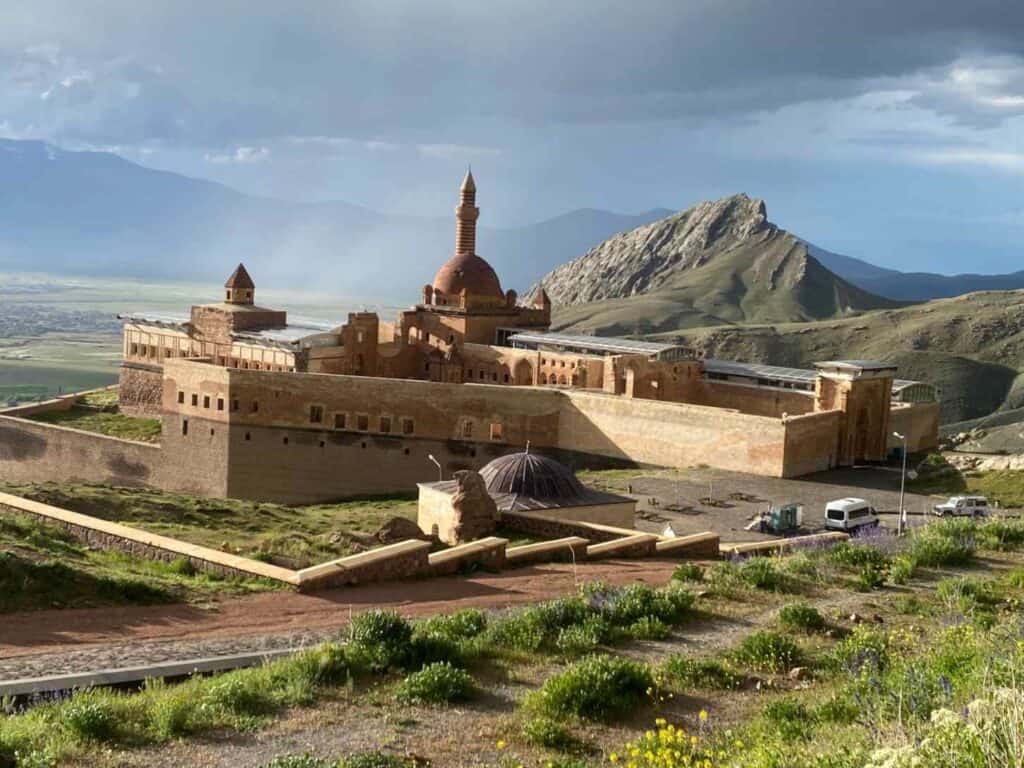This article may contain affiliate / compensated links. For full information, please see our disclaimer here.
The southern part of Eastern Turkey is inhabited mainly by Kurds, famous for their hospitality. This is also the region with the world’s most ancient civilizations of Upper Mesopotamia, the land between Tigris and Euphrates, and where people first converted to Christianity. Although domestic tourism thrives in this region, and there can be crowds in the summer months, foreign tourists are still rare. For that reason, you are treated more as a guest than a tourist. Eastern Turkey is much less known than the rest of the country, although this is where the traces of ancient civilizations are found. Its history, culture, and people are so different that it is considered a country within a country.
All you need to know before traveling to Eastern Turkey
Eastern Türkye is a relatively off-the-beaten destination, so much less information is available about it. This itinerary will be useful for planning your trip across Eastern Turkey. It is designed for those who arrive as individual travelers and travel by public transport. However, as you will see in the description, occasionally, you will need to use a taxi, where public transport is nonexistent or rare.
- Where to start your trip to Eastern Turkey?
- How to plan your trip to Eastern Turkey?
- What are the highlights of your trip to Eastern Turkey?
- Short itinerary
- Detailed Eastern Turkey travel itinerary
- Day 1: Gaziantep
- Day 2: Halfeti
- Day 3-4: Şanlıurfa (Urfa), Göbekli Tepe
- Göbekli Tepe, a half-day trip from Şanlıurfa
- Day 5: Mount Nemrut
- Day 6-7: Diyarbakır: the Kurdish capital of Turkey
- Day 8: Mardin, the White City
- Day 9: Deyrulzafaran monastery, Dara, Nusaybin
- Day 10: Midyat, Mor st. Gabriel, Mağaraköy (Kiwex) yezidi village
- Day 11: Hasankeyf, Van city
- Day 12: Van city and lake
- Day 13: Doğubayazıt
- Day 14: Ani, the Armenian ghost town
- How to visit Ani?
- How to get to Ani from Kars?
- Day 15: Erzurum
- Possible Extension: Continue to the Black Sea coast: Trabzon
- Other useful travel guides that might interest you
Where to start your trip to Eastern Turkey?
The best option is to start from Gaziantep and finish in Erzurum/Trabzon, depending on whether you want to include the Black Sea coast in your itinerary. Of course, you can also start from Trabzon/Erzurum and finish in Gaziantep.
Pegasus, Turkish Airlines, SunExpress, Onur Air and Anadolujet (Ajet) operate domestic flights in Turkey. All these cities are well connected to Istanbul and often have direct flights to European cities, mainly Germany.
All you need to know before traveling to Eastern Turkey
How to plan your trip to Eastern Turkey?
Flight: Find the cheapest flights to Bosnia and Herzegovina with Skyscanner or book flights, hotels, and local tours, rent a car, and benefit from immediate cashback through Wayaway! You can sign up for the Wayaway Membership program for only 49.99$! Use my discount code to get extra 10% off the subscription fee: VOG
Accommodation: Book hostels through hostelworld.com or look for both hostels and hotels in East Turkey on booking.com.
Local tours: Book city tours and other one or multi-day trips in Eastern Turkey through GetYourGuide or Viator
Rent a car: Find a great deal to rent a car with Discover Cars or Rentalcars.
Bus ticket: Book your bus ticket through 12GO in Eastern Turkey.
Travel insurance: Safetywing is a popular insurance among travelers that covers almost all countries (except Iran, North Korea, and Cuba). I also use it for my trips.
What are the highlights of your trip to Eastern Turkey?
– Mardin: the old hilltop town near the Syrian border with ancient mosques, madrasas and churches
– Diyarbakır: The Kurdish capital of southeastern Turkey is a vibrant city with a bustling bazaar, one of the most important mosques in the Islamic world, and over 5 kilometers of intact walls
– Mount Nemrut: One of Turkey’s most unique archaeological sites, where statues of deities lie scattered on top of Mount Nemrut. However, the road leading there is perhaps even more amazing!
– Sanliurfa (Urfa): a holy pilgrimage site and historically important city, with the cave where Abraham is said to have been born
– The incredible archaeological site of Göbekli Tepe, the world’s earliest religious center, is approximately 10,000- 12,000 years old and fundamentally overturned the idea of historians that the first form of religion was practiced after the origin of agriculture.
– Ancient Syrian Christian Orthodox churches, monasteries in a region where they were among the first to adopt Christianity
– Cruise the iconic Euphrates River at Halfeti, the Tigris River in Hasankeyf in Upper Mesopotamia
– See the Atatürk dam, one of the largest dams in the world
– Van: watch the sunset in the Van castle overlooking the largest lake in Turkey
– Doğubayazıt: the palace of Ishak Pasha and the snow-capped Mount Ararat rising above five thousand meters
– Ani: the scattered ruins of the former Armenian capital in a magnificent landscape
– Stopping at Yezidi and Assyrian villages and learn about the stories of these communities
– Visit the fantastic archeological museum in Sanliurfa and the mosaic museum in Gaziantep
– Enjoy the bustling bazaar in Diyarbakır, the Kurdish capital of Turkey
– Stay overnight in former caravanserais converted into hotels and try the wide variety of Turkish, Syrian, Kurdish, and Armenian food
All you need to know before traveling to Eastern Turkey
Short itinerary
Day 1: Gaziantep
Day 2: Halfeti
Day 3-4: Sanliurfa, Göbeklitepe
Day 5: Mount Nemrut
Day 6-7: Diyarbakır
Day 8: Mardin
Day 9: Deyrulzafaran monastery, Dara, Nusaybin
Day 10: Midyat, St Gabriel monastery, yezidi village
Day 11: Hasankeyf, Van city
Day 12: Van city and lake
Day 13: Doğubayazıt
Day 14: Kars, Ani
Day 15: Erzurum
Day 16-17: Trabzon
Detailed Eastern Turkey travel itinerary
This itinerary will start in Gaziantep and end in Trabzon. However, you can complete it in the opposite direction as well.
Day 1: Gaziantep
Gaziantep is the westernmost part of Turkey’s Southeastern Anatolia Region and one of the major cities with over 1.5 million inhabitants. Gaziantep was affected by the earthquake in 2023, and its castle is currently being restored. It has a majority Turkish population with a significant Kurdish minority and Syrian refugees.
Gaziantep is labeled as “the capital of the pistachio nut” and is said to have the best baklava in Turkey, which you can try in one of the almost 200 pastry shops. It even has the milky baklava that even of the city. Even those who are otherwise not fond of the traditional, very sweet version will like it. The most important attraction of Gaziantep is the Zeugma Museum, the largest mosaic museum in the world, containing 1700 m2 of mosaics. The precious mosaics were rescued from the nearby ancient Zeugma city, dating back to the 3rd century BC when it was flooded by the Birecik Dam built on the Euphrates. The museum is so famous that it is considered to be a must-see when traveling through Eastern Turkey.
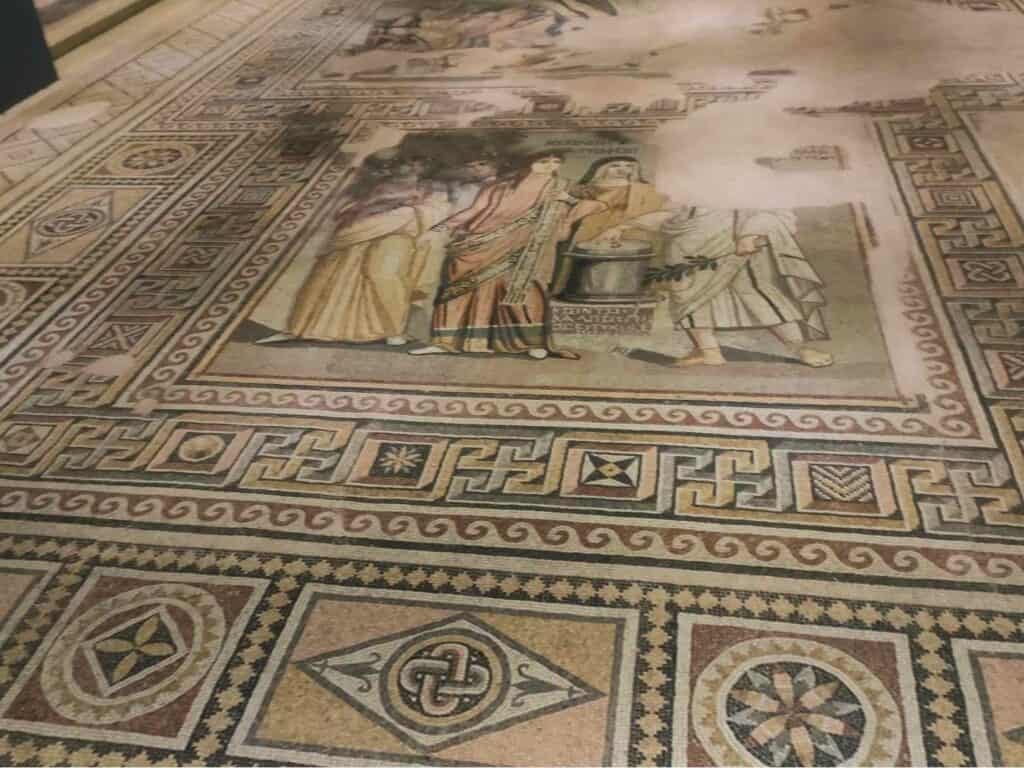
Zeugma mosaics were made from colored stone collected from the banks of the Euphrates, supplemented by glass tesserae for any missing colors, such as orange, light blue, or dark green. They were partly damaged during the Sassanian attacks, but they largely stayed intact. The mosaics covered the floors of affluent residential houses in Zeugma or even the bottom of the pools in the central courtyards.
Gaziantep was heavily damaged by the earthquake in 2023, but the Zeugma Museum was largely saved and could open only two and a half months after the tragic event.
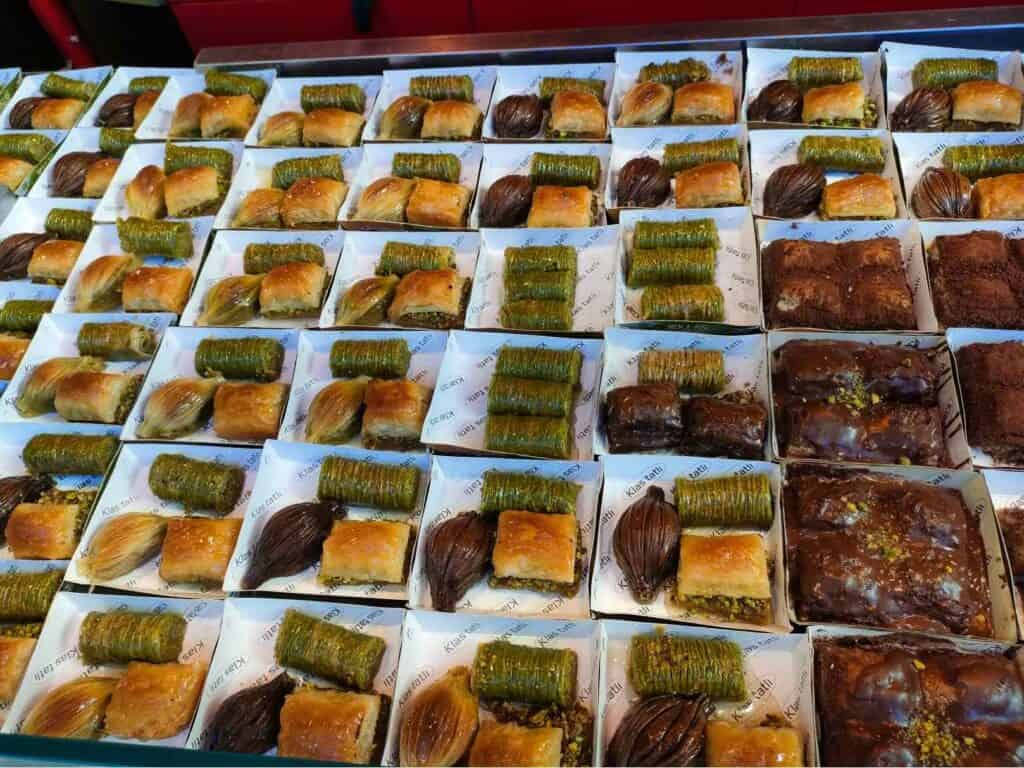
The castle in the center of the city is currently under construction. The area around the citadel has numerous mosques, “hans” (caravanserais) and old buildings. Gaziantep has a similar atmosphere to Aleppo in Syria, which is no surprise as the Governor of Aleppo built Gaziantep’s historical monuments during the Ottoman times. The two cities were closely linked before the artificial borders were drawn after World War I.
The Zincirli Bedesten Bazaar and Bakırcılar Çarşısı are good places to buy souvenirs, spices and nuts. It is worth visiting the Christian quarter (Bey Mahallesi), a 15-minute walk from the castle, which is located on a hillside.
Best things to do in Gaziantep:
– try some of the different sorts of baklavas
– stroll around the bazaars
– visit the famous Zeugma mosaic museum visit the famous Zeugma Mosaic Museum (open every day, entrance fee 12 EUR)
Where to sleep in Gaziantep?
Like many other cities in Eastern Turkey, Gaziantep also has hotels converted from Ottoman mansions. However, as a big city it offers accommodation for all budgets.
Low budget: Pamuk city hotel
Middle range: Ali Bey Konagi hotel
High end: Tas Konak Hotel
Day 2: Halfeti
Halfway between Gaziantep and Sanliurfa, Halfeti is a popular place for locals to spend the weekend. It is located on the banks of the Euphrates River, which remained the natural dividing line between the Roman/Byzantine and Arab/Islamic worlds throughout the 7th, 8th, 9th, and 10th centuries.
The best thing to do is to go on a one-and-a-half-hour boat ride on the Euphrates River. During the tour, you will see the Rumkale castle, one of the greatest medieval fortresses in Turkey, and have a short stop at another partly submerged village with a minaret standing out of the water. There are several boats a day, and usually, a party mood develops with local music and dancing on board.
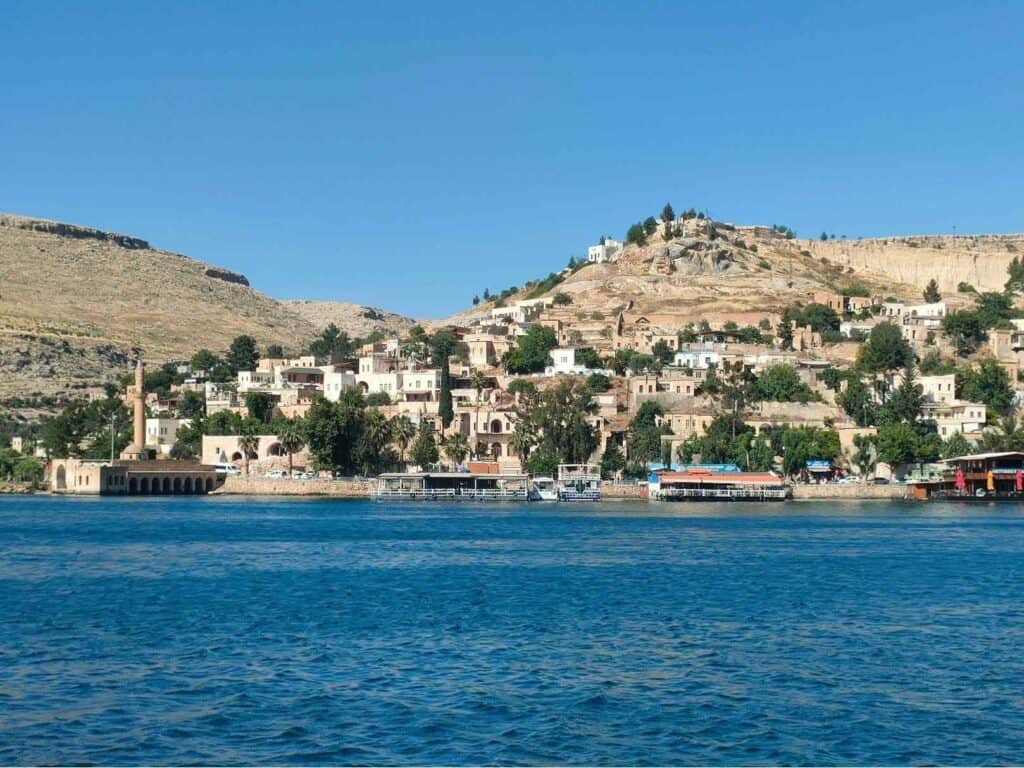
If you depart early enough from Gaziantep, you can probably still catch a bus late afternoon to Sanliurfa the same day. However, if you are too late, you need to spend an evening in Halfeti like I did. It has one main street, several nice restaurants on the river, and a couple of hotels with stunning views.
Halfeti, like many other villages and towns, was submerged by the Euphrates water when several series of dams were built in the 1990s as part of the GAP (Great Anatolian Project) initiated by the Turkish government to enhance the economic development and agriculture of this region. Before that, locals mainly earned their living from fishing and growing pistachio at the riverbank. The old town of Halfeti (Eski Halfeti) has strangely become a tourist attraction that has been benefiting from the catastrophe. At the same time, a few kilometers away, New Halfeti (Yeni Halfeti) was built to welcome the residents who had to leave their homes.
How to get to Halfeti from Gaziantep?
First, you need to take a bus to Birecik, where you can switch to a minibus that goes to Halfeti. The bus will probably drop you in new Halfeti (Yeni Halfeti), from where you should ask around where to take a bus that takes you down to old Halfeti (Halfei Esku) at the riverbank as there is no actual bus station.
Where to stay in Halfeti?
Low budget: Halfeti Bergamut butik hotel: This is where I stayed and
Mid-range: Hotel Kasr-i Canan
High end: Hotel CEVHER KONAĞI
The hotels with the nicest view are located on the hill. In this case the hotel will arrange your transfer to the hotel.
Day 3-4: Şanlıurfa (Urfa), Göbekli Tepe
Urfa is still primarily a pilgrimage town where most people come to see Abraham’s alleged birthplace. The number of foreigners is still less. We must mention that the Iraqi city of Ur is also referred to as such (I visited Abraham’s alleged house in Iraq with my group as a tour guide). Alexander the Great initially named the city Edessa, which in the 2nd century became the earliest Christian center in Mesopotamia. Even under Muslim rule (640-1035), it remained a predominantly Christian city, but today, half of the population is Arab and half Kurdish. The old town is dotted with old mosques and Christian churches, and its bazaar is one of the most atmospheric in Eastern Turkey. Don’t forget to try the liver kebab, the most famous specialty of Urfa. People in Urfa are said to be ready to eat liver (ciğer) at any time, even at 4 in the morning.
You can visit all the sights in Urfa on foot.
Best things to see in Urfa
– Museum of Archeology and Mosaics
Urfa has a surprisingly impressive museum of archeology located in a modern building. The museum gives an overview of the earliest civilizations in Upper Mesopotamia, accompanied by detailed English descriptions. It displays the remains of ancient Edessa, Göbekli Tepe, Karahan Tepe, and Harran and findings from the Southeastern Anatolia Project.
One of the museum’s main treasures is the “Urfa Man” statue, considered the world’s earliest life-size representation of a human and thought to date back to around 9000 BCE.
The mosaic museum is part of the cultural complex. Although Gaziantep boosts the world-famous Zeugma Museum, the one in Urfa is also impressive. Here, you can choose to make a short or a full round.
– Balıklıgölü (Abraham’s pool)
At the foot of the citadel, Balıklıgölü (Abraham’s holy pool) is the most important part of the city. Around the pools, there are many restaurants and cafes where families can sit and relax. In the cozy green park, it is worth sitting down for a drink and watching or mingling with people.
Abraham is revered by Jews, Christians, and Muslims, and all three religions regard him as the forefather of all prophets.
The Qur’an expands on the biblical story of Abraham by telling us that the Assyrian king Nimrod is warned by his astronomers that a child has been born who, when he grows up, will attack his rule and smash the idols in the temples.
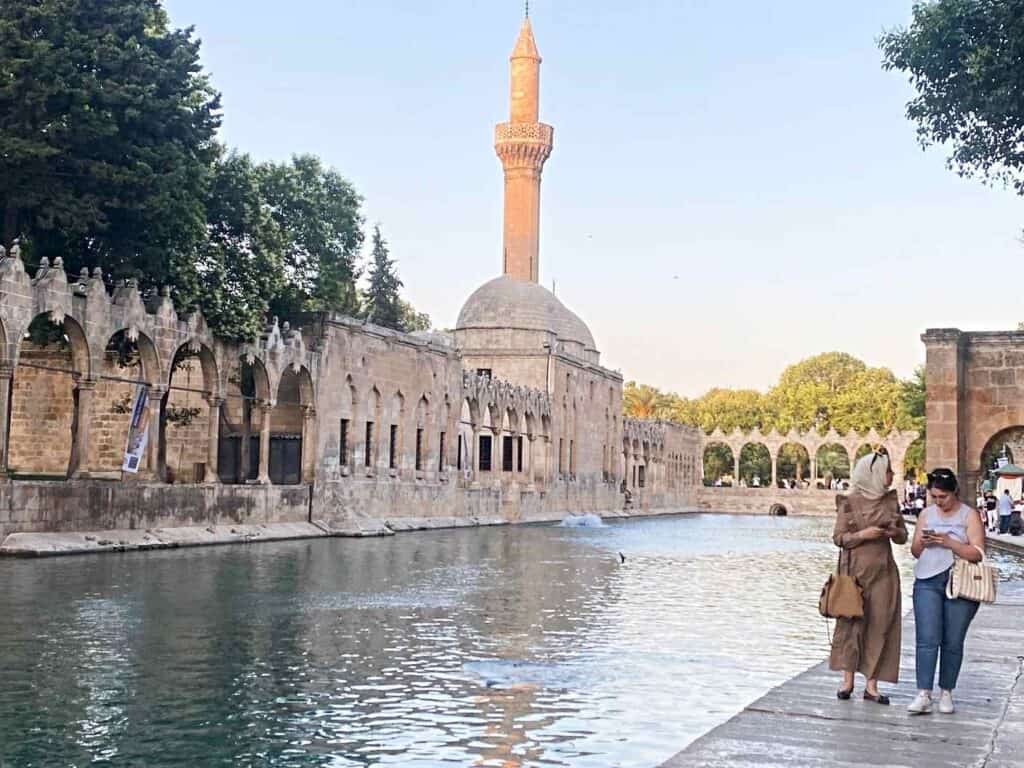
Abraham, born in the local cave, is thrown on the funeral pyre by the angry Nimrod but miraculously survives. God created a lake that extinguished the fire, and the burning coals became fish. Abraham’s pool is long, thin, rectangular, and surrounded by graceful arches. The carp swimming in the pool are forbidden to be caught as they are considered sacred, and anyone who eats one will go blind according to local superstition.
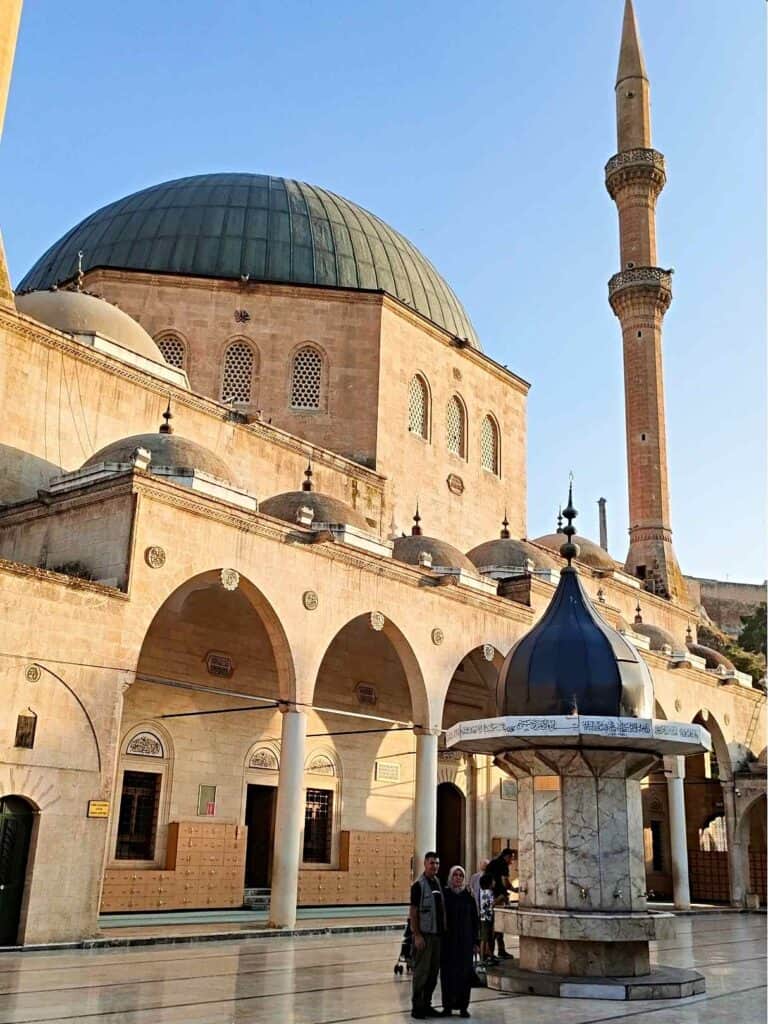
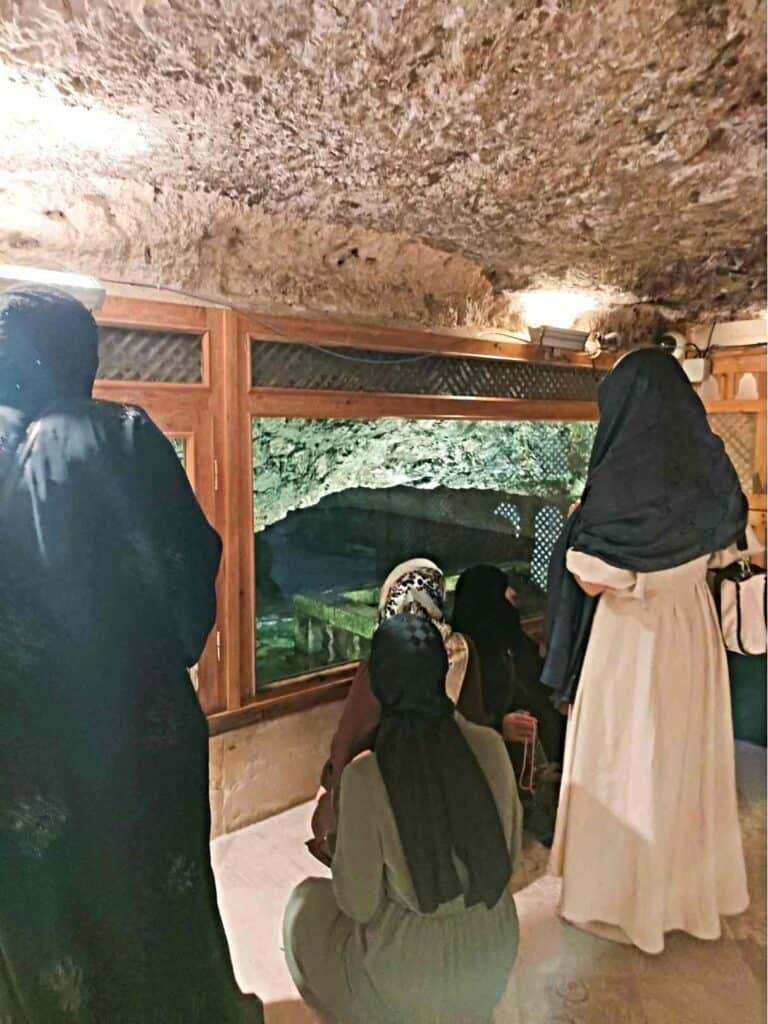
Abraham’s long, rectangular pool is surrounded by graceful arches, along which stand the Halil-Ur-Rahman and Razvaniye Mosque. According to local belief, the mosque, dating to the 13th century, was built at the spot where Abraham fell safely on the ground after God saved him from being killed in the funeral pyre.
– Abraham’s birthplace
You can access Abraham’s birthplace, the cave, through the Mevlid-I Halil Magarasi mosque located near the castle of Urfa and Balıklıgölü. It is usually not crowded. You must remove your shoes, dress modestly, and cover your hair with a scarf. Men and women can visit the cave separately. You will find people sitting and praying in front of the cave where Abraham was born. Abraham’s mother gave birth in secret since King Nimrod, fearing his life wanted to kill all newborns. The mosque is especially busy before Hajj (the pilgrimage to Mecca) when people come here for blessing.
Photography is allowed inside.
– Kızılkoyun Necropolis Archaeological Site
The vast necropolis, located near Balıklıgölü, is currently being excavated, which could be the largest in the world if the work is completed. So far, 133 rock tombs have been excavated, dating back 2,000 years to the time of the Kingdom of Edessa!
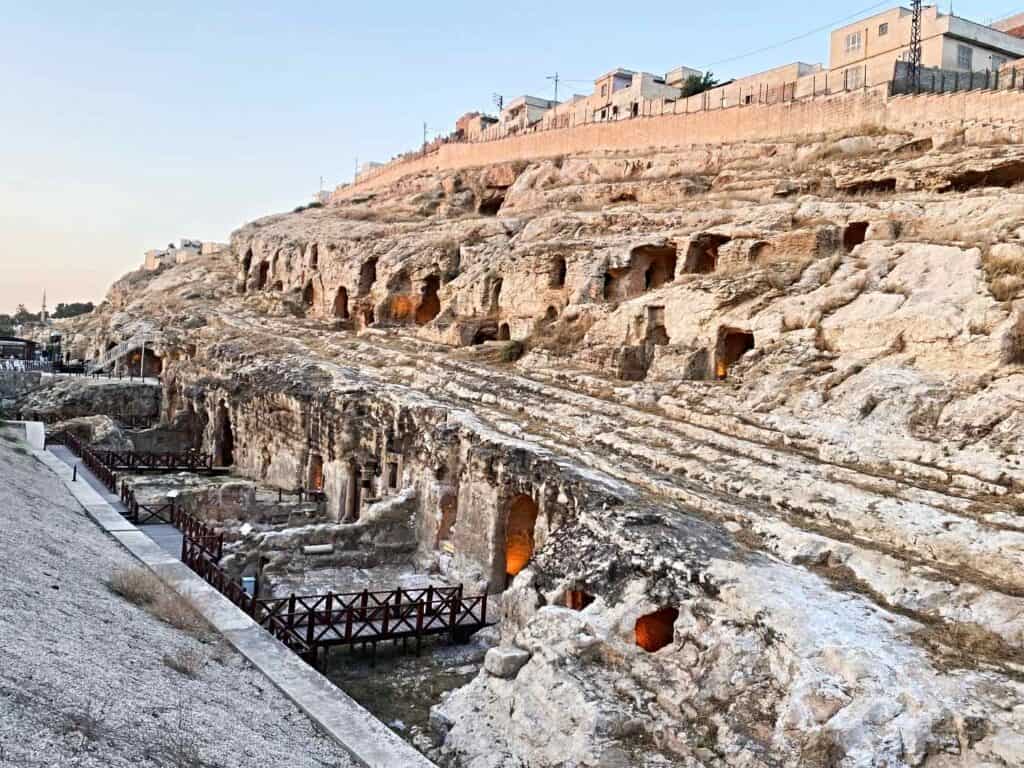
– Stroll around the bazaar and the narrow alley of the old town
In the narrow alleys, you find the Christian church of St Petrus and Paulus.
– The grand mosque of Şanlıurfa
The 12th-century mosque still bears several architectural elements of the former church at this place. During my visit, it was under reconstruction after being damaged by the earthquake in 2023.
How to get to Şanlıurfa?
From Old Halfeti (Yeni Halfeti), you take a minibus to New Halfeti, from where there are direct buses to Şanlıurfa.
Where to stay in Şanlıurfa?
Low-budget: Grand Babil Hotel
This is where I stayed. Located in the city center this small pleasant hotel with a central courtyard is a good place to stay for budget travelers. Breakfast is included in the price.
Karagül hotel is another excellent option for low budget travelers
Mid-range: Sarkciragan Boutique hotel
High-end: Babil Antique hotel
Göbekli Tepe, a half-day trip from Şanlıurfa
Once you are in Şanlıurfa, you must visit Göbekli Tepe, one of the most important archaeological sites in the world. Göbekli Tepe predates Stonehenge by six thousand years, where the remains of the world’s oldest known temples were discovered and, without exaggeration, rewrote our image of early human history and the birth of civilization. Göbekli Tepe is one of the first examples of man-made monumental architecture whose structures were used for rituals and religious purposes. So, the church was formed much earlier than the city, overturning previous theories.
Although excavations began in 1994 and have continued yearly since then, only a fraction of the site has been uncovered.
How to visit Göbekli Tepe?
There may be a few minibuses a day, but it is very time-consuming, so it is better to take a private taxi and agree on the price for your visit. Expect to pay approximately 700 TYR (~20 EUR).
Entrance fee to Göbekli Tepe: It was the most expensive attraction to visit in Eastern Turkey (21 EUR). The visit starts with the museum, which explains the history of Göbekli Tepe in detail through movies and descriptions. From the museum, you walk through a corridor where you can get some souvenirs. You will reach the actual archeological site in a few minutes with a minibus.
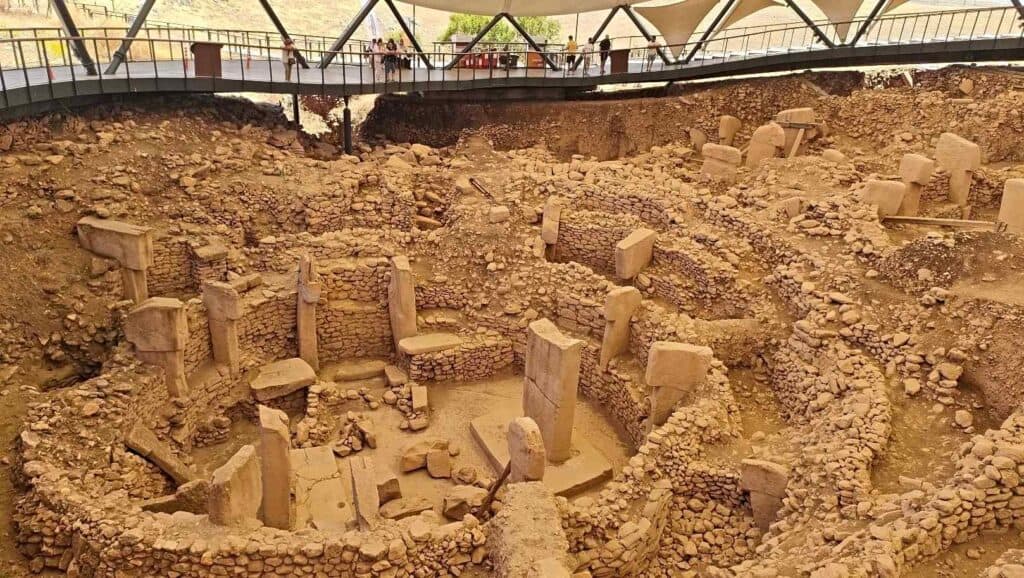
Short story of Göbekli Tepe
The first churches in the world were built in a round shape, and this was no accident. The man of his time looked around and saw the sun, the moon, and the stars as the most magnificent manifestations of his universe. However, these were inaccessible to him, and he subconsciously associated them with the divine and wanted to worship them. He believed that they had some mysterious power over him. The circle remained the divine symbol in later art and architecture, the only shape that has no beginning and no end. Therefore, it symbolizes infinity, the never-ending cycle of nature.
Eight structures have been discovered so far, and they are marked by letters from A to H, indicating the order of discovery.
The 3-5.5 meter high T-shaped pillars carved from a single piece of limestone are the most characteristic parts of the churches. They were built into the wall at a certain distance from each other, and two were placed in the middle.
At least 20 more such stone temples are hoped to be excavated, some of them larger than any other. The stone circles are believed to have been built in carefully designed circular hollows at least 20 meters in diameter. Each hollow follows the same pattern, with a pair of giant T-shaped monoliths in the center surrounded by 12 smaller stone monoliths in a circle.
Each stone monolith was carved differently. Some are extremely complex and covered with several animal motifs, such as vulture-like birds, snakes, scorpions, and spiders. Others are quite simple, with only one animal on them, such as a fox, wild boar, lion, or bull. In addition to the animal motifs, human elements appear, which are probably representations of superhuman beings.
There are still many mysteries to be solved on Göbekli Tepe. How were these gigantic stones brought here? Who designed and decided what the carvings should be? How many people participated in their construction? What were the ceremonies held here?
The answers are still being sought, but it was clear that a large and skilled workforce was needed, which researchers thought would not exist until much later. Previously, it was believed that monumental architecture with complex sculpture and symbolism began 5,000 years ago in Egypt and Mesopotamia, but it turned out that here, at Göbekli Tepe, people had already built such monuments 6,000 years earlier! Göbekli Tepe may have served as a “central sacred place” for the entire region, where people gathered to or build these structures together and worship their common “gods”.
Karahantepe:
If you are interested in archeological sites, you can also visit Karahantepe, which is closely related to Göbekli Tepe. It may be the earliest human village, dating to 9,000- 11,000 BC, even predating Göbekli Tepe. So far, they have excavated around 250 obelisks featuring animal figures. I didn’t venture to this place, but I heard the only way to get there was by taxi, and the road was quite bumpy. Göbekli Tepe and Karahan Tepe will make a day trip from Şanlıurfa if you visit both.
Day 5: Mount Nemrut
One of the main reasons many people venture to this part of the country is to see the stone sculptures of Mount Nemrut (Nimrod). It is strange, but in the end, it was not the statues of the deities lying on the ground but the entire landscape that captivated me. They organize visits from Kahta, where I stayed, and from Adıyaman, which is a little further away, and there is no other way to get here. Both towns were affected by the catastrophic earthquake that claimed countless lives last year. Listening to our driver, I quickly understood that it is still engraved in people’s memory.
Historically, Nemrut Dağı does not have much significance, as it is nothing more than a burial monument of the ruler of a small local dynasty, yet it cannot be compared to anything else in the world. This kingdom stretching from Adıyaman to Gaziantep was called Commagene. It was founded by a local ruler named Mithradates in the 1st century BC after the collapse of the Seleucid dynasty, which was established by one of Alexander the Great’s generals. Commagene rulers ruled independently until 72 AD, when Emperor Vespasian annexed it to his Roman province, Syria.
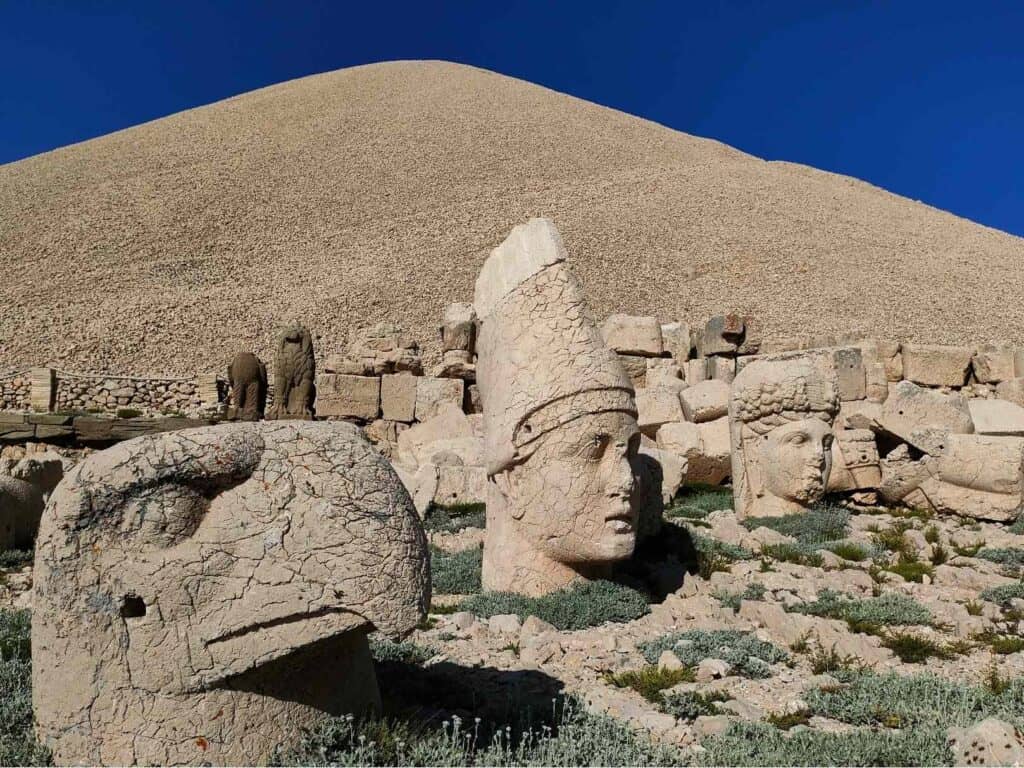
Antiochus (62–32 BCE), son of Mithradates, claimed that he was the descendant of Alexander the Great on his father’s side. This Persian and Macedonian origin is reflected in the sculptures and bas-reliefs, where Antiochus portrays himself as equal to the great kings and gods. Statues of gods include Apollo, the Commagene fertility goddess, as the only female figure; Zeus, Antiochus himself and Hercules. Their heads fell to the ground due to earthquakes and extreme hot and cold weather over the centuries. The ruler chose a peculiar spot for his mausoleum: on the highest mountain of his empire at approximately 2,200 meters. The location is extremely remote and inaccessible, which gives the place covered in snow from mid-October to the end of April a surreal atmosphere.
The view of the group of statues is said to be particularly beautiful at sunrise and sunset.
How to visit Mount Nemrut?
There is no public transport, but hotels organize tours mainly during sunrise and sunset to Mount Nemrut, when it is said to be the most beautiful.
The tour takes approximately 5 hours and costs 25-30 EUR.
On the way to the mountain, we stopped at a bridge from the time of the Romans, as well as at the burial place of Antiochus’ wife, from where you can see the highest point of the peak of Nemrut Dağı, the burial place of her husband. The queen’s tomb has a beautiful view of the lake created by the Atatürk Dam, built in 1992. Next to the dam, you can also see the famous Mesopotamian river, the Euphrates. The Atatürk Dam is the central element of the Southeast Anatolia project aimed at developing the vast southeastern Turkey. If you are in your own car, you can stop to see the fourth largest dam in the world, 200 meters high, which supplies the whole of Southeastern Turkey with water and electricity on the way from Urfa to Kahta.
The group of statues has two main parts: the Western and Eastern blocks on two sides of the hill. A well-marked path leads from one part to the other.
Where to stay in Kahta?
Low-mid budget: Taşsaray Bardakçı Hotel and Kommageneiz Hotel
Hotel Nemrut
How to go to Kahta?
From Şanlıurfa, there are regular buses to Adıyaman (2 hours), from where you can take another bus to Kahta.
Day 6-7: Diyarbakır: the Kurdish capital of Turkey
With more than one million inhabitants, it is the largest Kurdish-speaking city in the world and the second most populous city in southeastern Turkey after Gaziantep. With the expulsion of the Armenians during and immediately after World War I, Kurds settled en masse. Diyarbakır is surrounded by a 5.5 km long, almost completely preserved wall system. The Armenian, Christian, Kurdish, and Arab neighborhoods with narrow, winding streets have developed, each with its own community buildings, churches, and mosques. In 2015-16, there were heavy clashes between the Turkish army and the Kurdistan Workers’ Party insurgents seeking independence, which turned much of the old city into ruins. However, today, almost nothing is visible from the destruction.
Best things to see in Diyarbakır
– Great Mosque (Ulu Cami)
It was originally the Cathedral of St. Thomas, the largest church in Diyarbakır, but was later transformed into the city’s main mosque during the Arab conquest in the 7th century. Even today, it is one of the oldest mosques in the country and is considered the fifth most important holy place (Harem-i-Şerifi) in Islam. It was clearly modeled after the 7th-century Great Umayyad Mosque in Damascus and, like it, was used as a pagan temple in pre-Christian times.
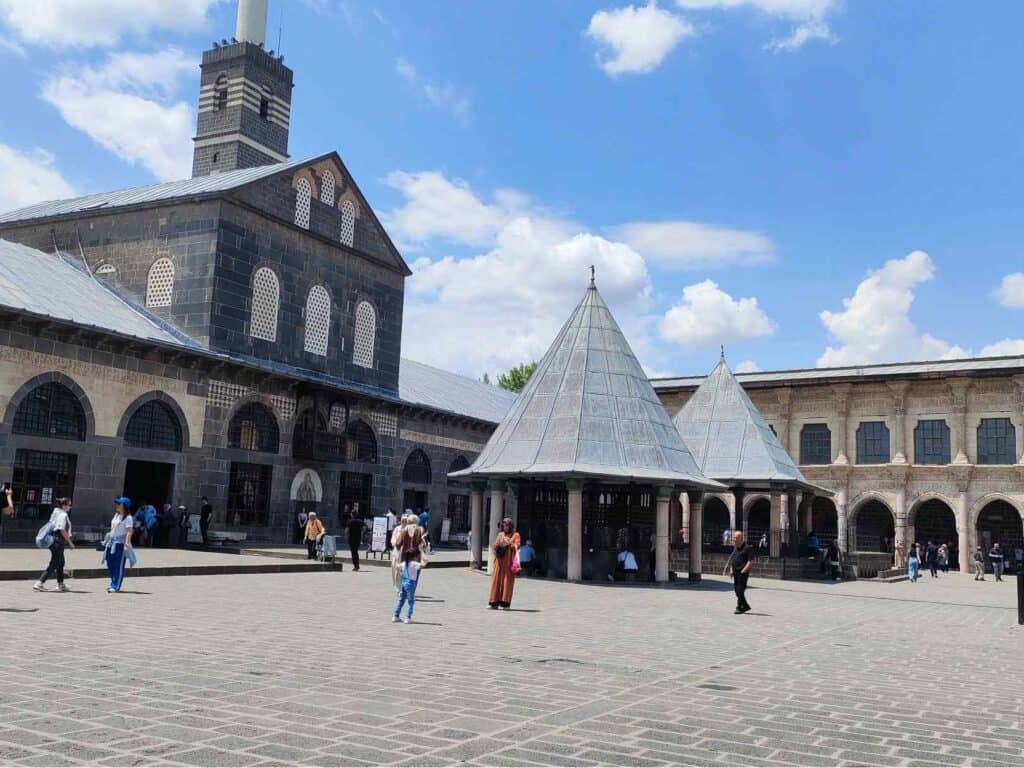
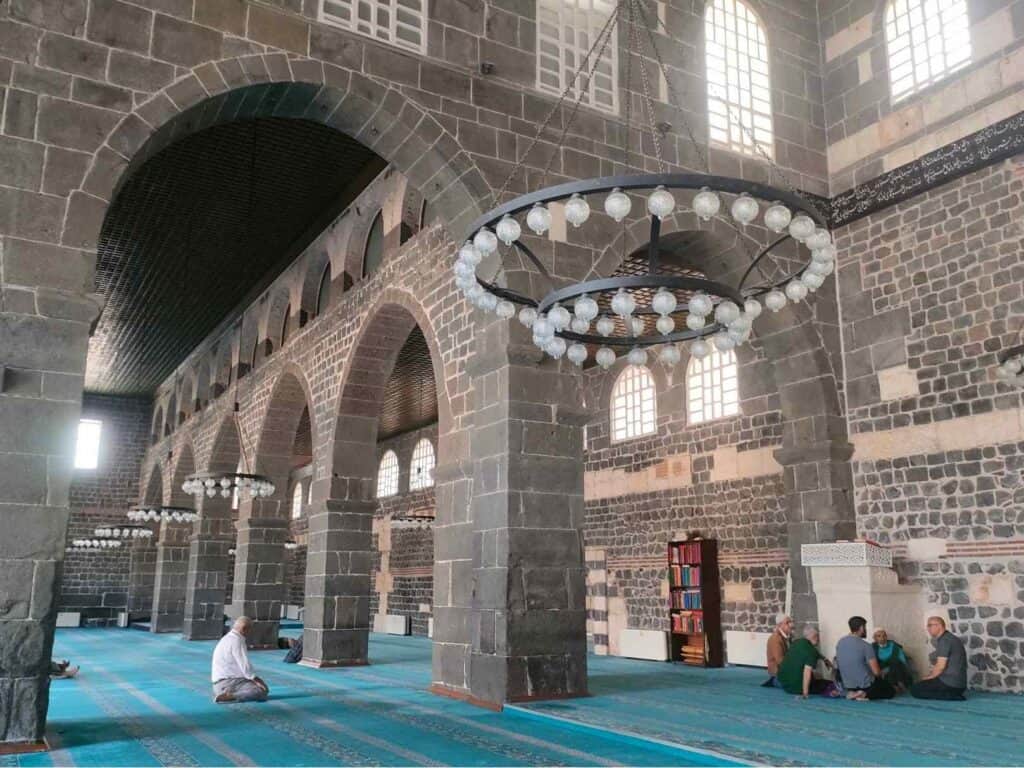
– Hasan Paşa Hanı
On the main street, almost opposite Ulu Cami, is the ever-busy, black-and-white-striped Hasan Paşa Hanı, a huge caravanserai built in 1572-75, with a two-story arcade overlooking the courtyard and a central fountain. It has a wonderful atmosphere. At the entrance, I was offered a Kurdish coffee specialty with a nutty flavor. The stables inside that were once able to accommodate 500 horses are occupied by cafés, restaurants, and shops selling carpets, jewelry, and antiques. Diyarbakır was the center of Armenian and Syrian silversmithing for centuries, and today’s Kurdish masters carry on their traditions.
– The four-pillared minaret, Dört Ayaklı Minare
It takes its name from the four pillars supporting the free-standing minaret. The four basalt pillars are about 2 meters high, so people can walk right under them. According to local legend, walking around seven times will make their wishes come true. It is believed that the pillars represent the four schools of Islamic law, and the axis of the minaret itself is the body of Islam.
– Visit some of Diyarbakır’s famous churches
Surp Giragos is the largest Armenian church in the Middle East, which was confiscated by the Turkish government in 2016 but reopened in 2022 after renovations.
Over the centuries, most of the churches of the various Christian denominations fell into ruin as the communities dwindled, but some still stand, such as the Syrian Orthodox Church of the Virgin Mary.
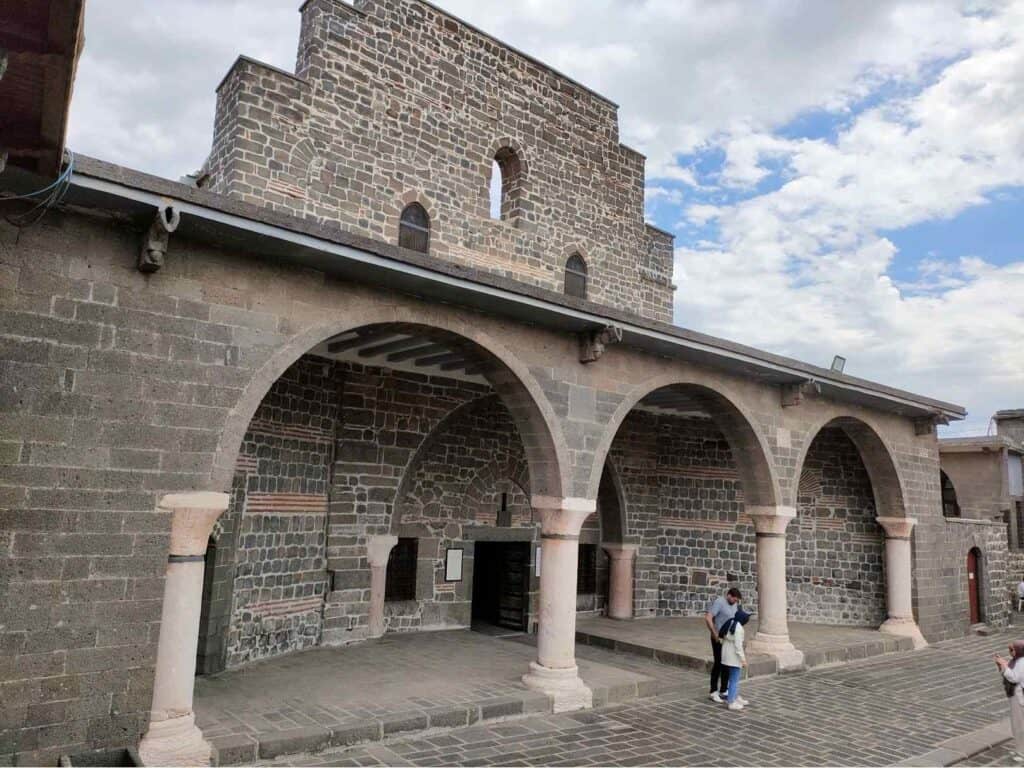
– Listen to the traditional storytellers at Dengbêj House
I had a very special experience at the Dengbêj House. Anatolian wandering singers were frequent guests of the coffeehouses of Istanbul at the turn of the century. However, while they have disappeared there, you can still meet them in Eastern Anatolian cities. Wandering singers perform epics, folk songs, and their own compositions, perform regularly, and have competitions. In the Dengbêj Ház, some well-known dengbêj perform daily between 10 a.m. and 4 p.m.
– Stroll around the bustling bazaar
In the evening, the streets get crowded, and the city, almost entirely inhabited by Kurds, becomes lively. You can stay in restaurants with cozy courtyards and in hotels converted from caravanserais.
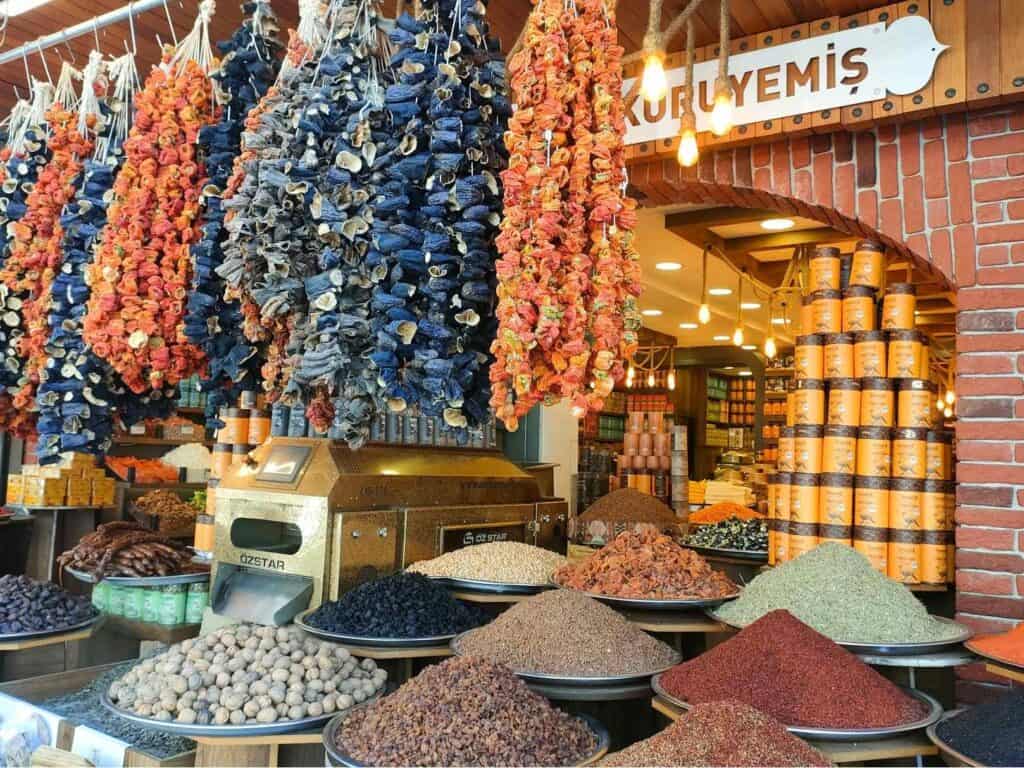
– Climb the walls for a nice view of the city
There are several spots where you can climb the walls for free and enjoy a great view over the city
Where to stay in Diyarbakır?
Low-budget: Konak hotel Surici
Mid-range: The Green Park hotel
High-end: Amida Boutique Hotel
How to get to Diyarbakır?
If you stay in Kahta, first you take a dolmus from Kahta to Adiyaman. From Adiyaman, there are several minibuses to Diyarbakir.
Day 8: Mardin, the White City
The charm of Mardin is given by the group of houses carved out of stone built on top of the mountain.
Unlike the black Diyarbakır, Mardin is sometimes called the “White City” because of the characteristic pale limestone used here. The exterior of the buildings is decorated with beautiful, ornate carvings. This architectural style dates back to pre-Ottoman times. Syriac Christians made up slightly less than half of the population from the 5th century to 1910, but most left the city during the persecutions of 1915. Although the proportions have changed a lot, the mixture of Arab, Syrian Christian, and Kurdish cultures gives the city its special atmosphere.
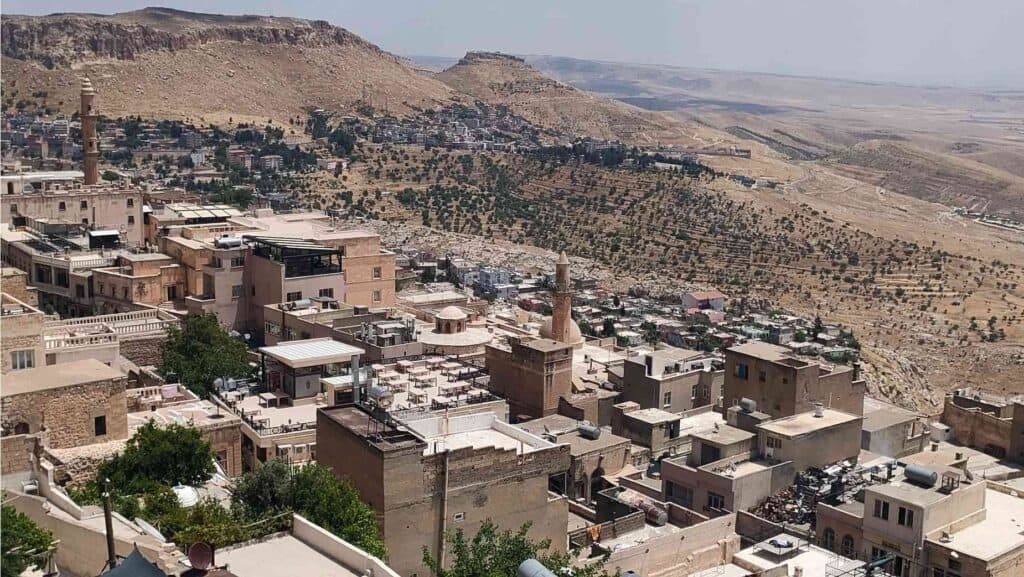
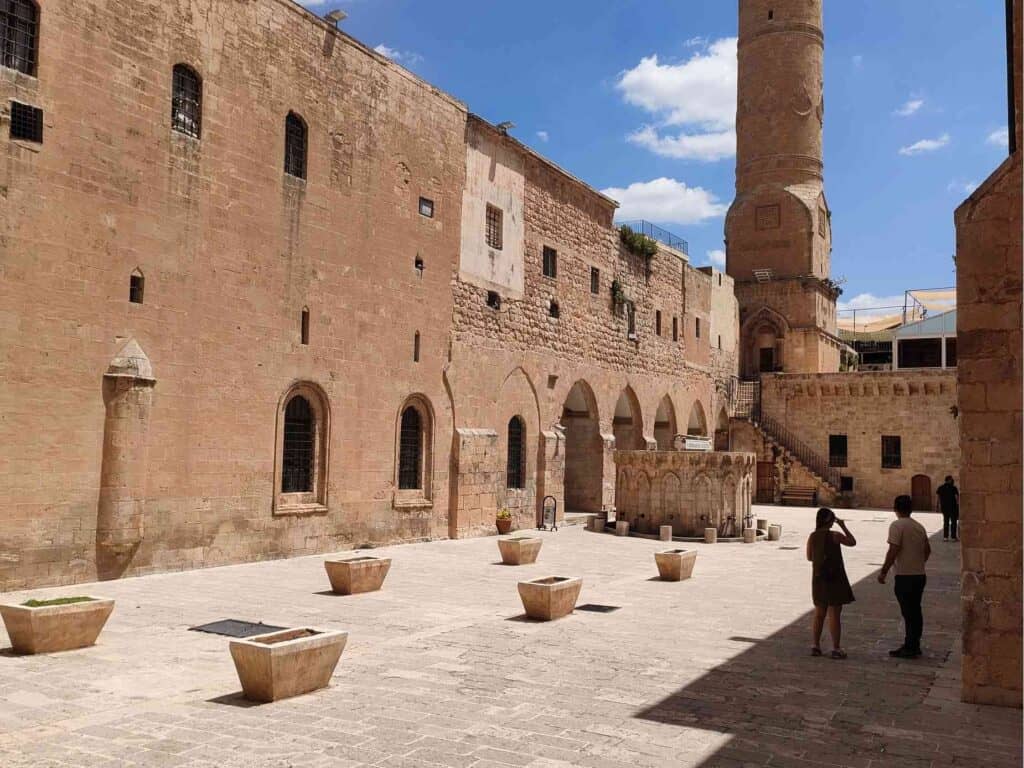
There are many cozy boutique hotels in Mardin, many of which are former mansions built in the 14th century. Due to Mardin’s location, there are large differences in level, but it is definitely worth climbing up to the Zinciriye madrasa. Not only the complex itself but also the view from there is fantastic.
Wandering through the steep zigzag streets of Mardin, one comes across countless attractions, such as the Great Mosque, madrasa, Christian churches, galleries, museums, and shops selling handicrafts. One of Mardin’s most famous products is soap, of which there are countless, and each of them has a different beneficial effect. The pistachio soap keeps hair and skin in good condition thanks to its exceptionally high composition. But there is also mandala or olive oil soap. All are hand-made and hand-cut.
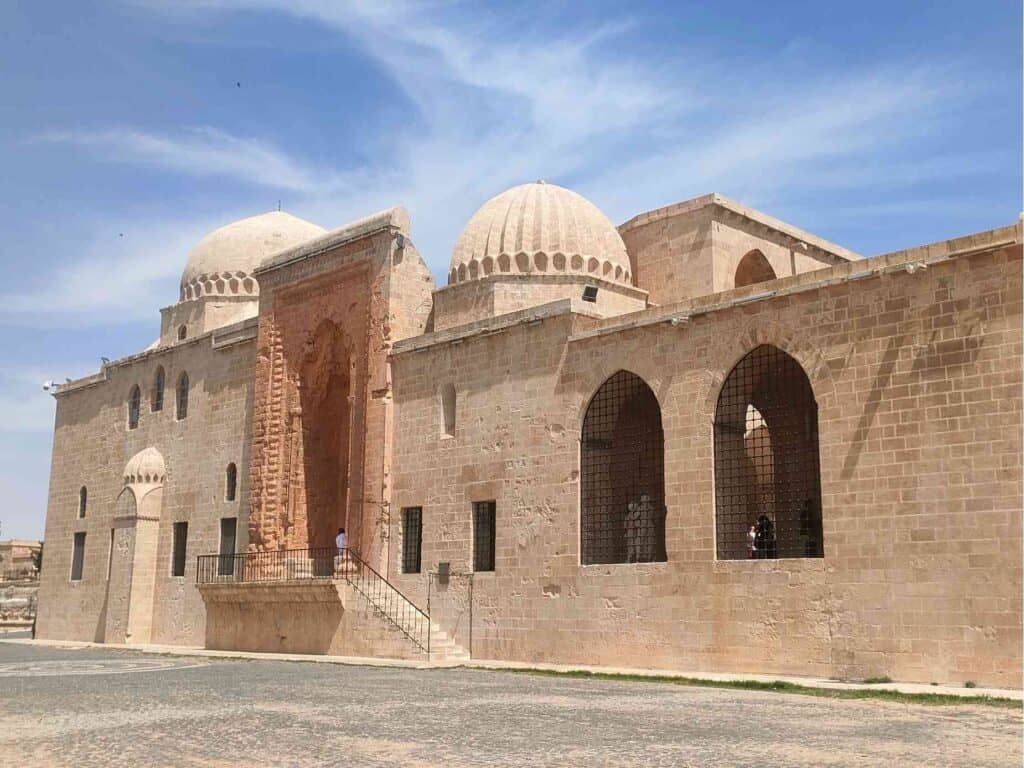
The best things to do in Mardin:
– Mardin Museum: closed on Monday, entrance fee for foreigners ~10-12 EUR
– Zinciriye madrasa: stunning Islamic architecture and view of the city!
– Grand mosque of Mardin (Ulu Cami)
– Bazaar and shops selling Mardin soap
– Kasimiye madrasa
– Forty Martyrs Church (Kırklar Kilesesi): a 4th-century church
Day 9: Deyrulzafaran monastery, Dara, Nusaybin
Deyrulzafaran monastery
South of Diyarbakır, down from the Tigris to the Syrian border, rises the Tur Abdin Plateau, an important center of Syrian Christianity. The Aramaic-speaking population here was among the first to adopt Christianity in the 3rd century. This Syrian Christian community, constantly facing the Muslim conquerors, could only survive with great sacrifices. That is why Tur Abdin is such a special place historically. Today, it is the only significant Christian area in Turkey.
Deyrulzafaran is the most famous and easily accessible Syrian Orthodox monastery near Mardin. From 1160 to the 1920s, it was the most important monastery and seat of the Syrian Orthodox Patriarchate.
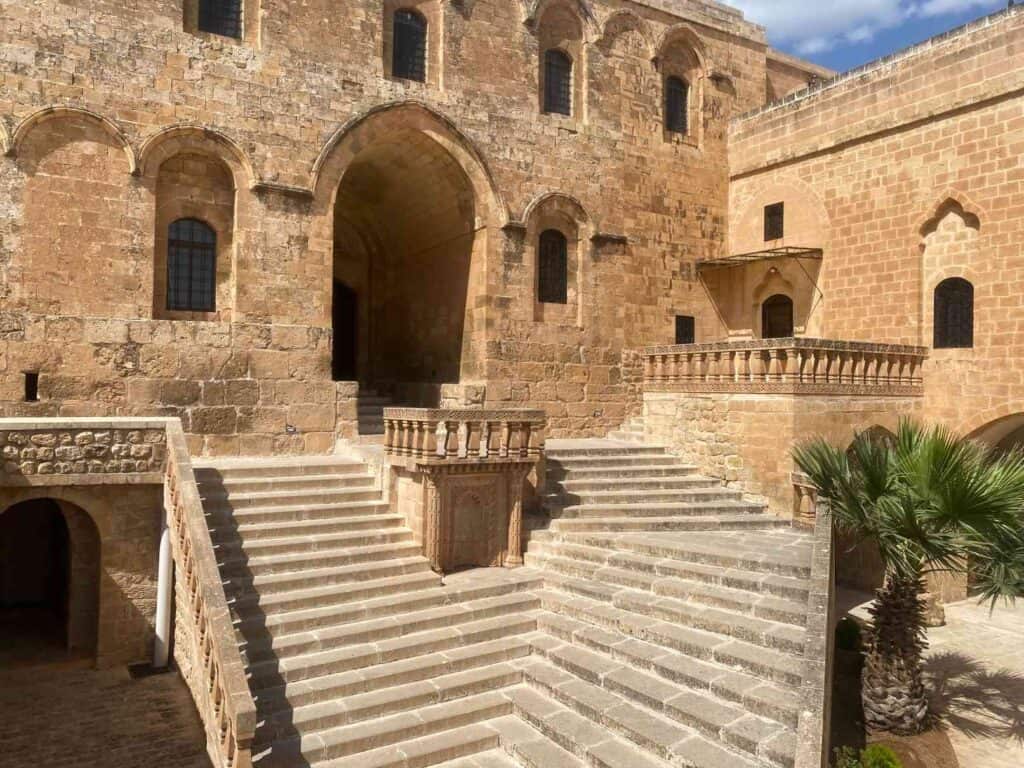
On the way to Mardin visit Dara and Nusaybin
Dara (Anastasiopolis)
Originally built on the border of the Roman and Persian empires, Dara is now located between Mardin and Nusaybin on the Syrian border. Its ruins lie scattered around a dusty Kurdish village. It was garrisoned by Emperor Anastasius in 507 AD, served as a defensive outpost on the borders of the Persian Empire, and was overrun by the Persians a century later. The ruins fall into several distinct areas, and the most notable are the developed water system of quarries, tombs, and cisterns. A unique example of early Roman water technology can be observed here. Eight channels are carved out of the hillside to a depth of 6 meters, in which the flow of water is controlled by a sluice system. Dara is believed to be the site of Mesopotamia’s first dam and irrigation canals. The vaulted cistern looks like an underground cathedral.
Unfortunately, I couldn’t take a picture of this because the underground parts were completely dark due to temporary power outage.
However, the rock-hewn necropolis was spectacular with its impressive cave-like tombs. Some of the caves were later used as churches.
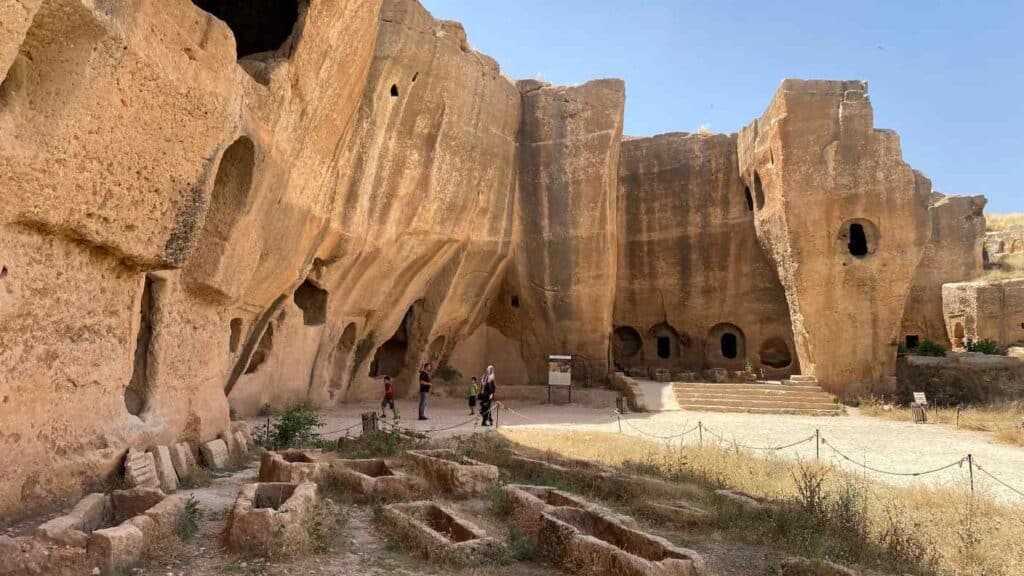
How to get to Dara from Mardin?
There is no public transport from Mardin to Dara, so you have to negotiate the price with a taxi driver. I visited Dara and then asked him to take me to Nusaybin to the Mor Yacob (Saint Jacob Church) and drop me off at the smugglers’ bazaar.
Nusaybin
It was a big surprise and I’m glad that I decided to visit the Mor Yacob (St. Jacob) Church in Nusaybin, which is said to have been the baptistery of the former church. They do not know exactly whether it belonged to the Church of the East or the Syrian Orthodox Church, in any case, the atmosphere of the beautifully lit 4th century church was very captivating.
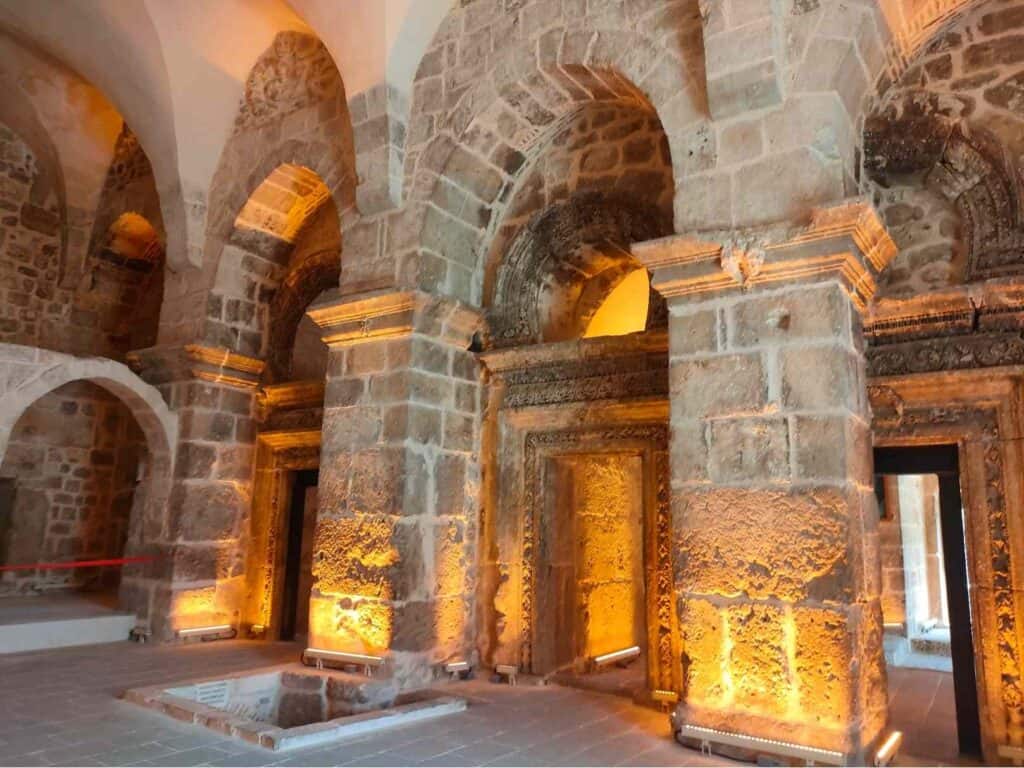
Nusaybin is very close to the Syrian border, we actually drove within arm’s reach of the border marked by the fence. Nusaybin also has a “smugglers’ bazaar” where they sell all kinds of goods brought from neighboring countries.
I heard before that people in Nusaybin are particularly kind and welcoming. Although I only spent a few hours there, this was confirmed when a man whom I met in a public park invited us to his home. I kindly declined though, as we still had many programs and wanted to reach Mydiat by evening.
From Nusaybin you can take a minibus to Midyat.
As there is no public transport, you may prefer signing up for a guided to tour to visit Mardin’s old city, Deyrulzafaran monastery and Dara.
Day 10: Midyat, Mor st. Gabriel, Mağaraköy (Kiwex) yezidi village
Midyat has a part similar to Mardin, only much smaller. This is the old part of the town. Most of the Syrian Christians who once lived here have abandoned their beautiful ancient houses, which have been largely occupied by Kurds. In Midyat, just like in Mardin, there are many restaurants with roof terraces, and the most famous attraction is the traditional guest house, Midyat Konak Evi.
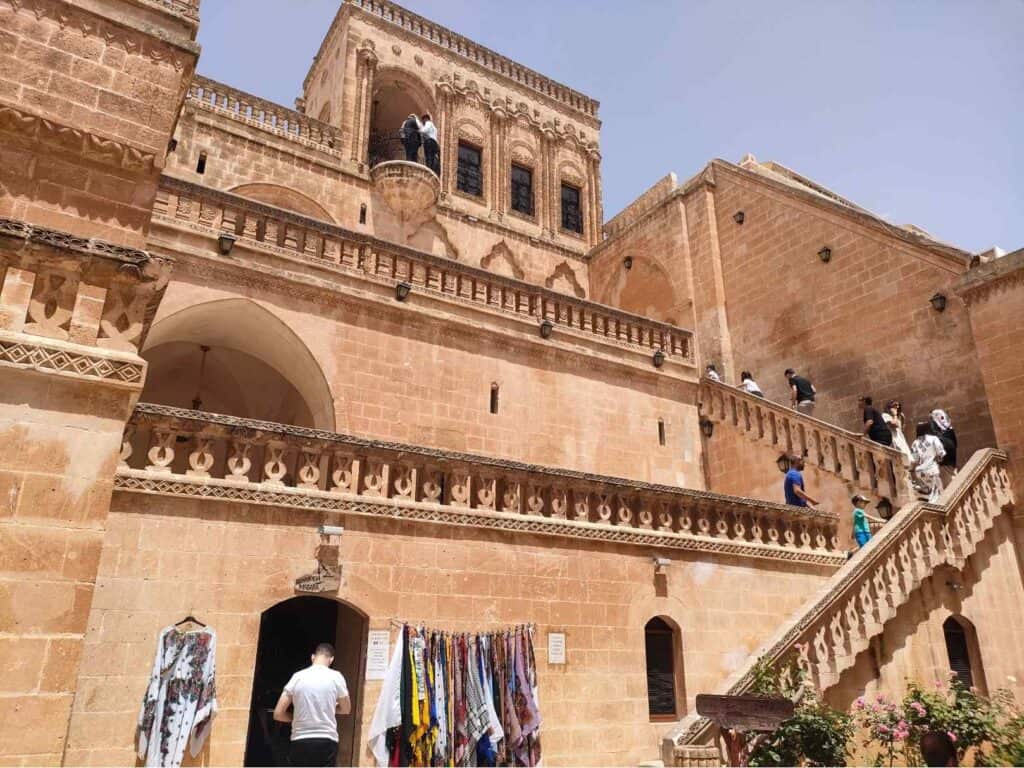
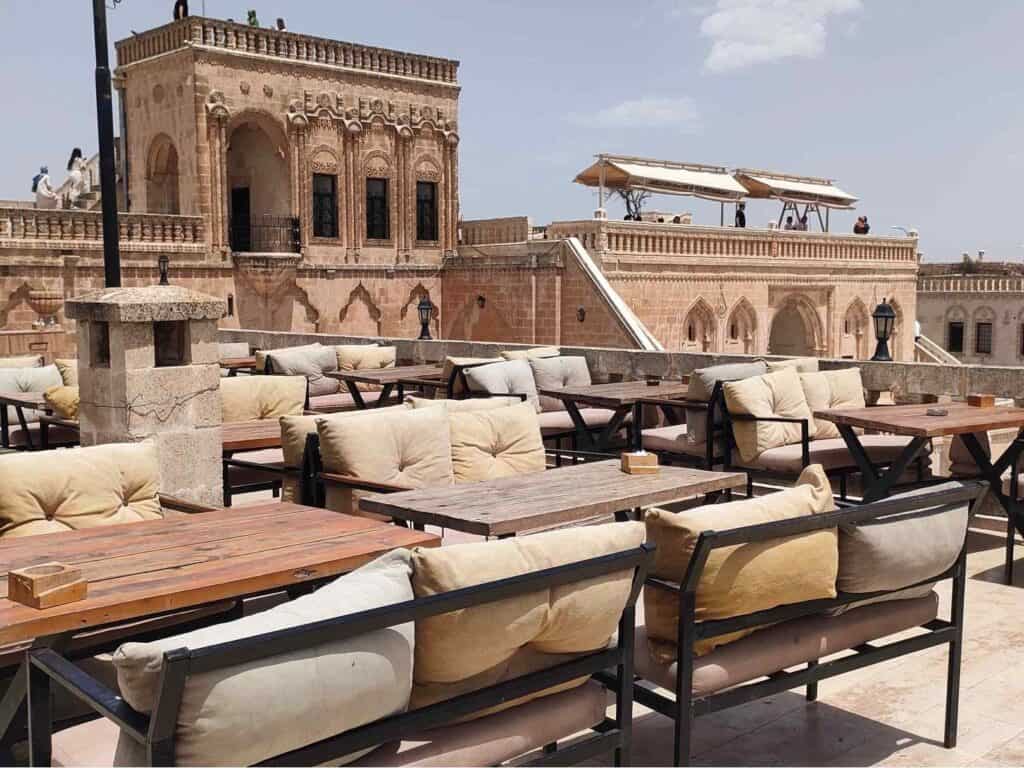
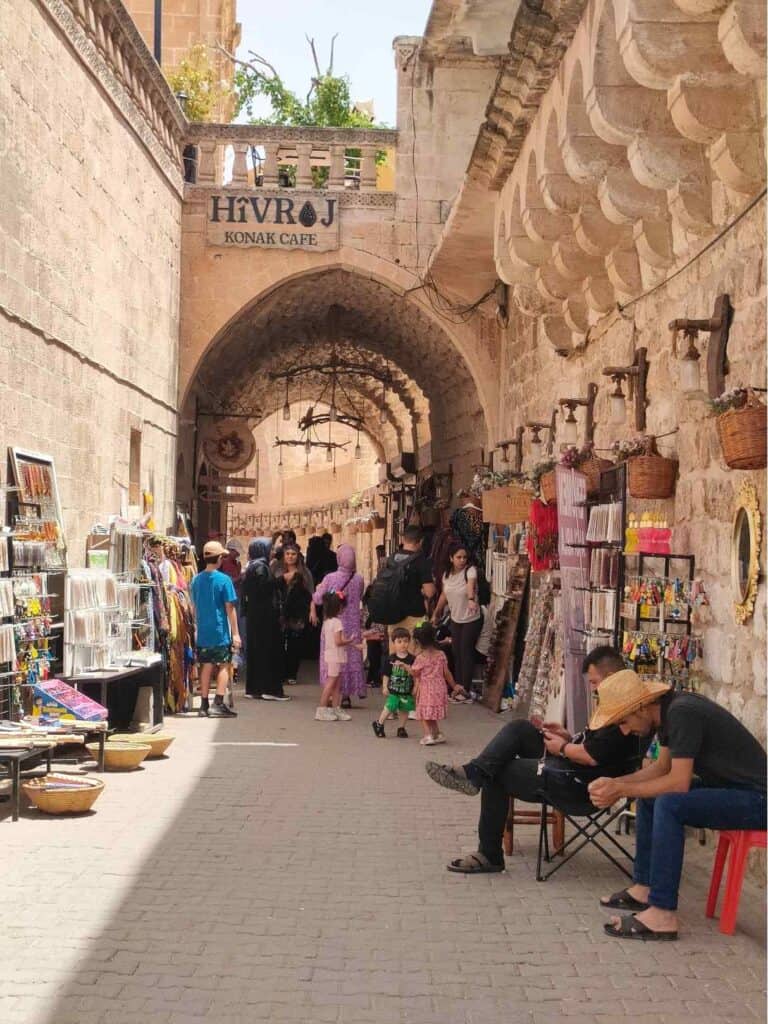
From Midyat, we visited the St. Gabriel Syrian Christian Orthodox monastery and an abandoned Yezidi village, Mağaraköy. I hadn’t heard or read about it until I was walking in Mardin and saw it on offer at a local office that organizes excursions. I was also very interested because I visited the holy place of the Yezidi people in Lalish, Iraq.
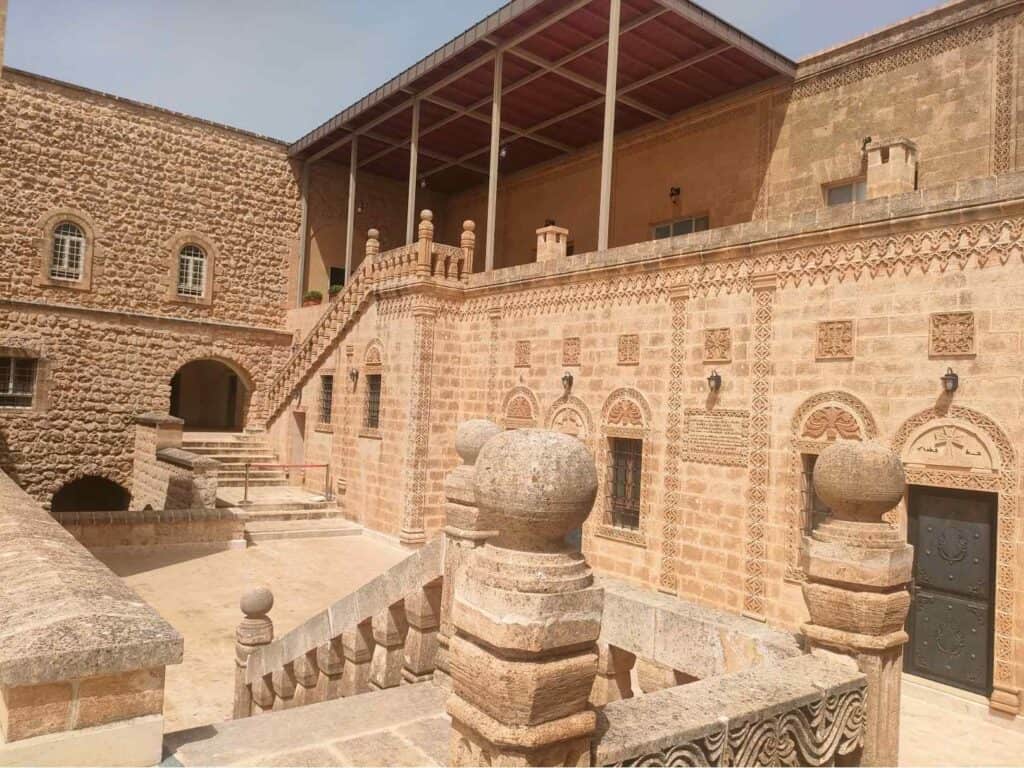
Yezidis believe in one God, who entrusted seven angels with the rule of the universe. Malak Tawus (Melek Taus), the “Peacock Angel” is the most divine of all and is God’s connection to the earth. Yezidis often decorate their homes with peacock symbols and pray directly to them, angering orthodox Muslims. In addition, they do not have a holy book like the other major religions. Throughout their history, the Yezidis tried to preserve their religion amid persecution, for which it is essential that they marry among themselves.
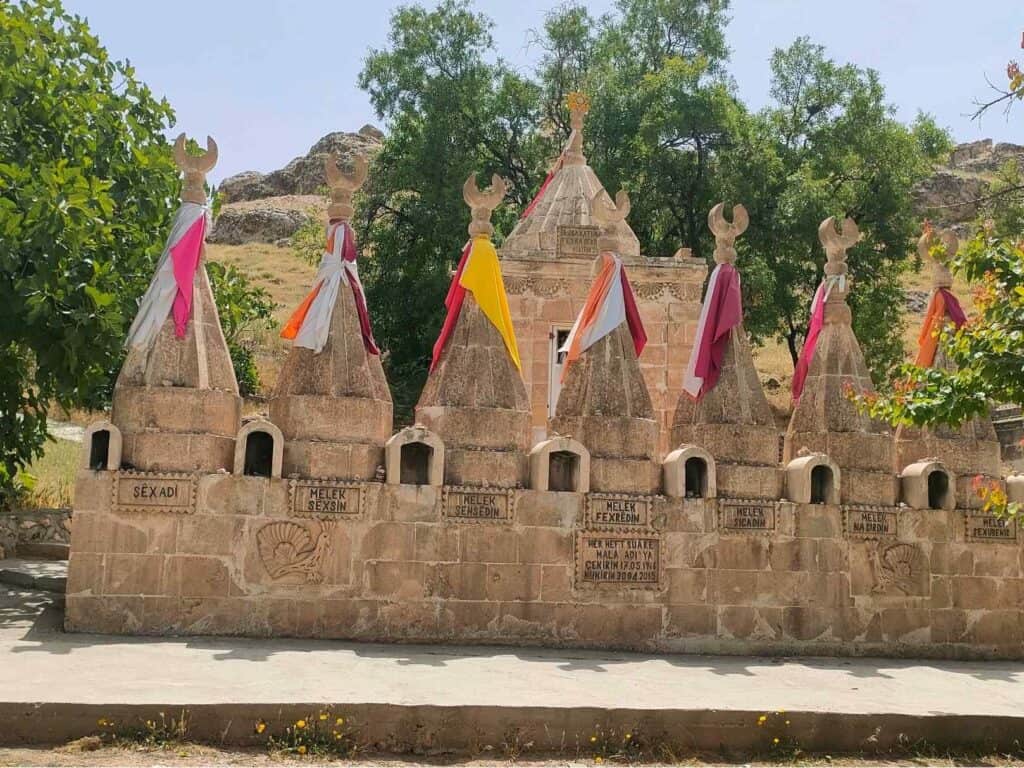
Since there is no public transport to the monastery and Yezidi village, I negotiated the price with the driver to both places (~30 EUR) and back to Midyat.
Both places were definitely worth the visit.
If you are interested in visiting even more villages in the countryside around Midyat, you can head to Kafro (Elbegendi), a revived Syriac village, or Killit, an abandoned Syriac Christian village. There are several hidden gems in the Tur Abdin Plateau, an important center of Syrian Christianity.
Day 11: Hasankeyf, Van city
Hasankeyf
On the way from Midyat to Batman, you can ask the driver to stop at the highway at the crossing, where you can walk down to Hasankeyf.
Hasankeyf has a rich history as the former capital of the Artukid Empire in the 12th century. During this time, a bridge was built across the Tigris River. From 1232, the town served as the capital of the Kurdish Ayyubid kings, descendants of Saladin, before falling to the Ottomans in 1416.
In Halfeti, you could take a boat on the Euphrates River, and in Hasankeyf, on the Tigris River. Like Halfeti, Hasankeyf also fell victim to the flooding caused by the construction of dams.
By July 2020, the ancient town, along with ancient relics such as tombs, mosques, and churches, was completely submerged in the dam’s waters. Many residents were relocated to a new Hasankeyf built at a high level on the opposite side of the river. The World Monuments Fund listed Hasankeyf as one of the 100 Most Endangered Sites in the world.
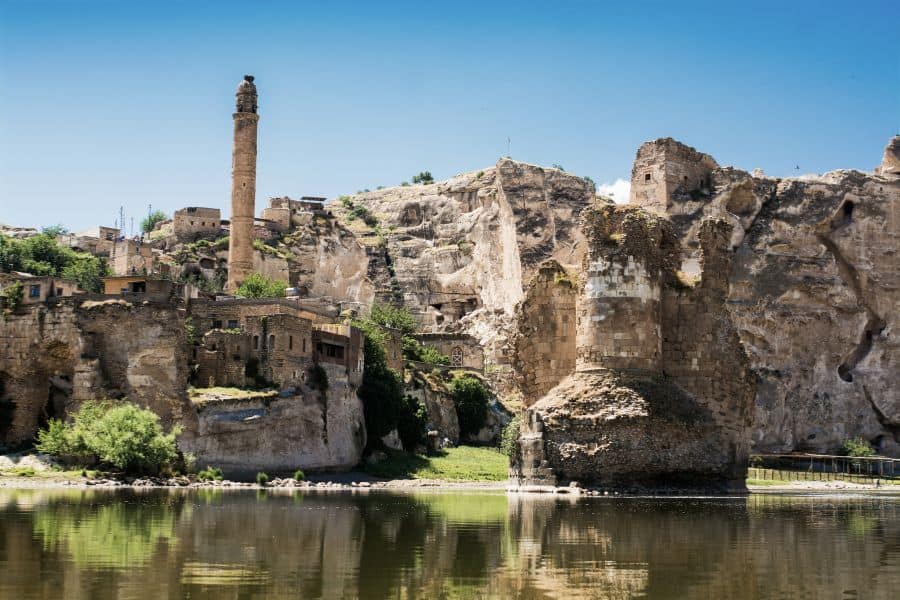
Due to the project’s controversy, international investors revoked their support, and Turkey had to rely on internal financing to construct the dam.
On the cliff top above the town, you can see the ruins of the Artukid city; some caves are still inhabited by troglodyte families. Most local people are Kurdish here, with very few Arabs.
How to go to Van from Hasankeyf?
Return to the highway where you got off and flag down a dolmus heading to Batman. From Batman, several buses, including night buses, depart daily for Van City. The journey to Van city will take around 6 hours.
You need one or two days in Van depending on what you want to visit. If you plan to go to the Akdamar island you will probably need two days.
Day 12: Van city and lake
Van is a strikingly modern, bustling city that seems to have been built only recently with brand-new residential buildings, shopping malls, and wide streets. Most of the population is Kurdish, but once, it was the heart of Armenian kingdoms with a significant Armenian population. The fate of Armenians in Turkey is a sensitive topic, and Turkey has a different view of the Armenians who died or were deported during 1915-1918. Despite all that, some 70,000 Armenians still live in Turkey today.
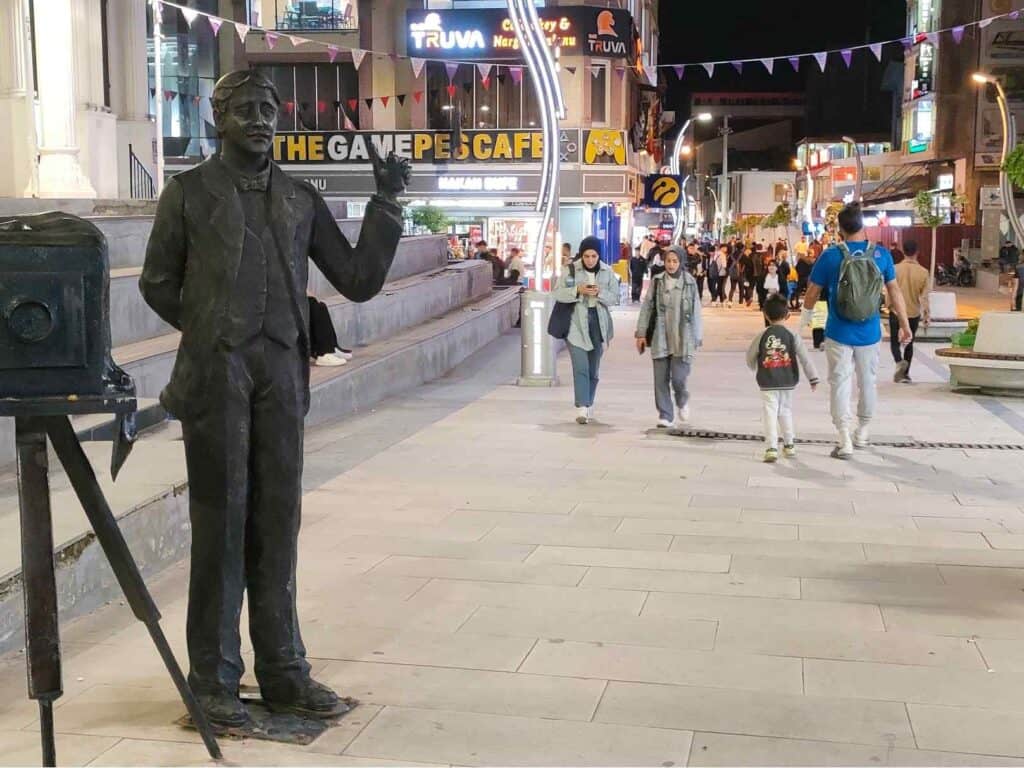
The Van region has a distinct history. The Urartians created a great empire and ruled from 900 BC to 500 BC. However, the Hurrian ancestors of the Hittites were the first rulers here in the 2nd millennium BC.
Overthrowing the Assyrian Empire, the Persian Medes ended the Urartian rule. In 331 BC, on his way to Persia, Alexander took the Van region, and after his death, it became part of the Seleucid Empire. When the Romans overthrew the Seleucids, the territory passed for a time into Roman hands. The Armenian king Tigranes the Great, of the family of Artaksias of the Huns, captured Van from the Romans and founded the first Armenian kingdom here, called Vaspurakan. It was defeated by the Arabs in the 7th century and remained under Islamic control for centuries.
The Van region is well known as a fertile land, and this is where the famous cantaloupe melon originates.
Van Lake, at 1750 meters above sea level, is the largest in Turkey and has a serene atmosphere surrounded by peaks rising to 3,000m and even 4,000m. The lake has no outflow and is six times saltier than the sea, which means that people can float more than swim here. The water is incredibly clear but remains pretty cold in the summer months.
When you are in Van, visit the Van Kalesi, the massive Urartian citadel from which you can best view the city and the lake, especially at sunset.
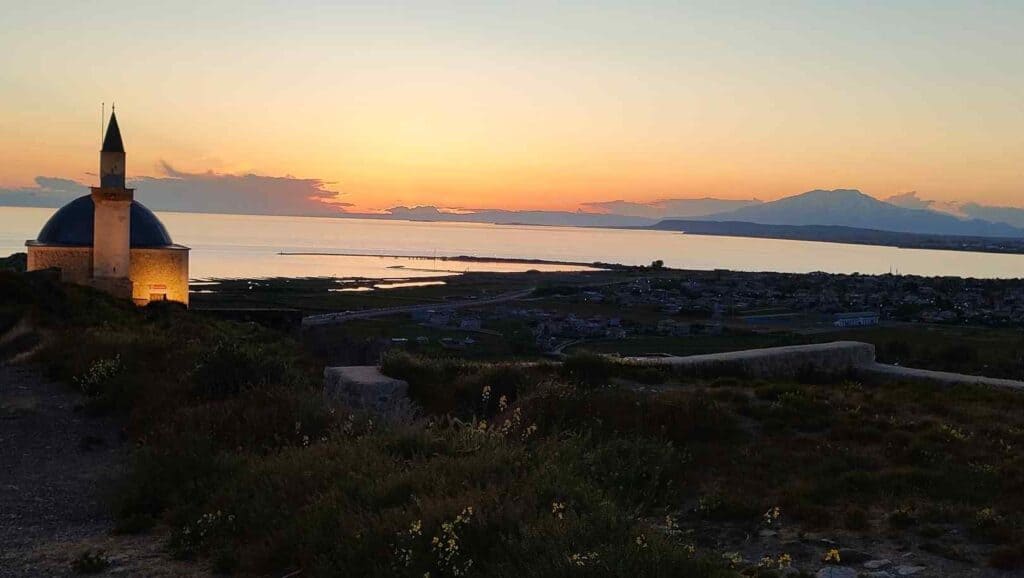
Akdamar island
The most popular program in Van City is a day trip to Akdamar island. Here stands the famous Church of the Holy Cross of Akdamar, built under the Armenian kingdom of Vaspurakan. In September 2010, the Turkish government permitted an Armenian church to hold service for the first time after almost 100 years. The event was of huge significance and even attracted the world press.
I didn’t have time for that and spent the day in the city instead. However, I was told that buses leave from the central bus station to Gevaş, the nearest city, from where you either take a short bus ride or a taxi to the port. In peak season, boats leave once they get full. In low season, you probably have to wait longer.
How to get there?
Walk to the dolmus/minibus station just beyond the end of Cumhuriyet Caddesi, where buses run to the main “otogar” (bus station).
Where to stay in Van?
Low budget: Van Backpackers Hostel
Mid-range: Toprak Hotel
High end: The Conforium Hotel Van
Day 13: Doğubayazıt
People travel to Doğubayazıt for two reasons: the Mount Ararat and the Ishak Pasha palace
The palace was built by Beyazit’s provincial bey, finished by his successor, and named after him. It is a special Turkish palace that was not built specifically in the Ottoman style but combines Anatolian, Persian, and northern Mesopotamian features.
The entrance fee is 3 Euro and is closed on Monday.
The café above the monastery offers a spectacular view, so it is worth staying for a while after the visit. However, the Ararat mountain is not visible from here.
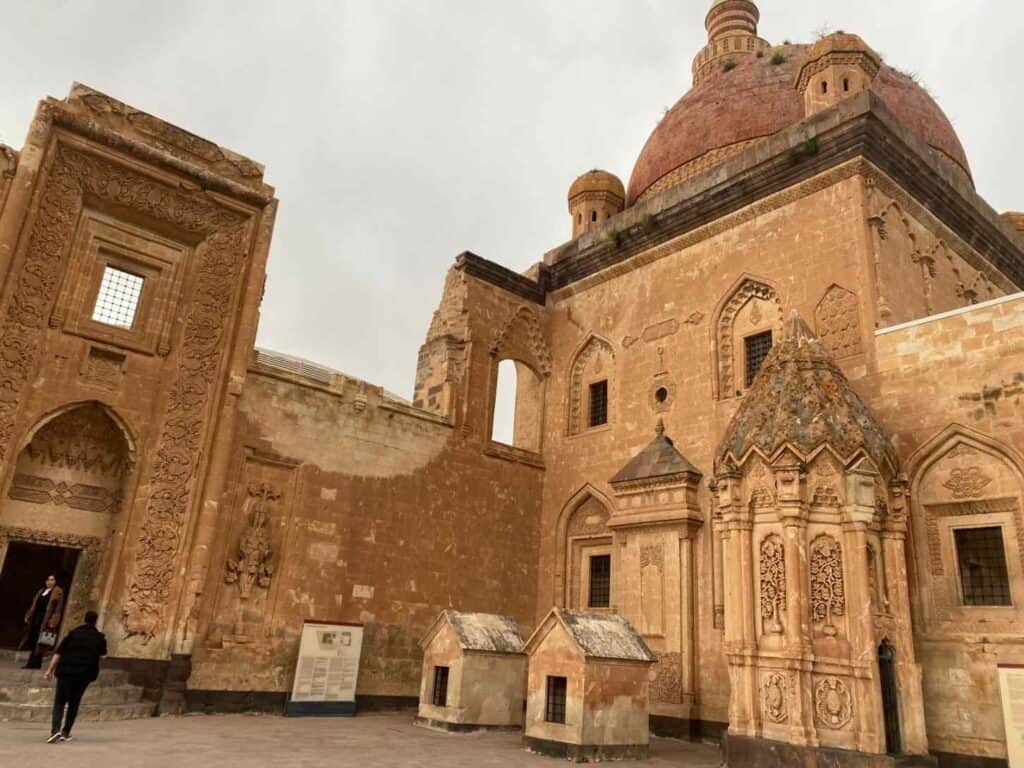
How to get to the Ishak Pasha palace?
There are minibuses (dolmuş) from the center to the palace; however, outside peak season (June-August), they are not so frequent, and you probably have to wait longer. The same applies on the way back. The easiest way is to take a taxi. One way costs 200 TRY.
Doğubayazıt is the closest city in Turkey to the 5,137-meter-high Mount Ararat.
According to Armenian tradition, Ararat is the center of the universe, and the Armenians believe they have descended from the mountain’s slopes. Ararat is supposed to be the source of the two great rivers, the Tigris and the Euphrates, bringing life and civilization to the open plains of Mesopotamia.
Ararat is also mentioned in Genesis as the place where Noah’s ark landed after the flood. In the 1970s and 1980s, many people set out to find the remains of the ark, and there is indeed a place that is shown to tourists as such. The Turkish government also created the Noah’s Ark National Park around the supposed site. Many do not consider this likely. For this reason, I didn’t make an extra tour to visit this place.
In clear weather, you can see the Ararat mountain well from the center of Doğubayazıt. However, you can get the best view of the sacred mountain 10 km outside the city, so you should negotiate the price with the taxi driver.
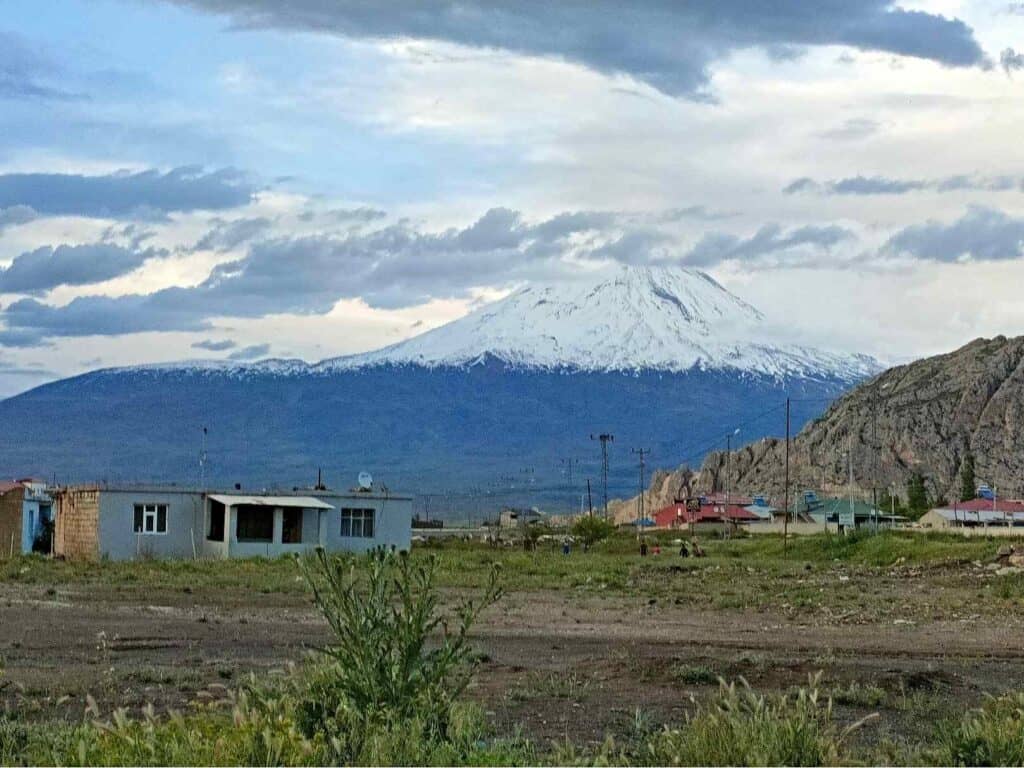
Where to stay in Doğubayazıt?
Low budget: Erzurum hotel
Located along the main street, this is a popular option for low-budget travelers. Rooms are small but clean; you can have them for around 750 TYR.
Middle range: Tehran Boutique Hotel
Day 14: Ani, the Armenian ghost town
I traveled to this out-of-the-way place near the Armenian-Georgian border just to see one of the most interesting sights in Eastern Turkey, the ruins of Ani. Until 1989, a special permit was required to reach the place in the 700-meter no man’s land between the Armenian Soviet Socialist Republic and Turkey.
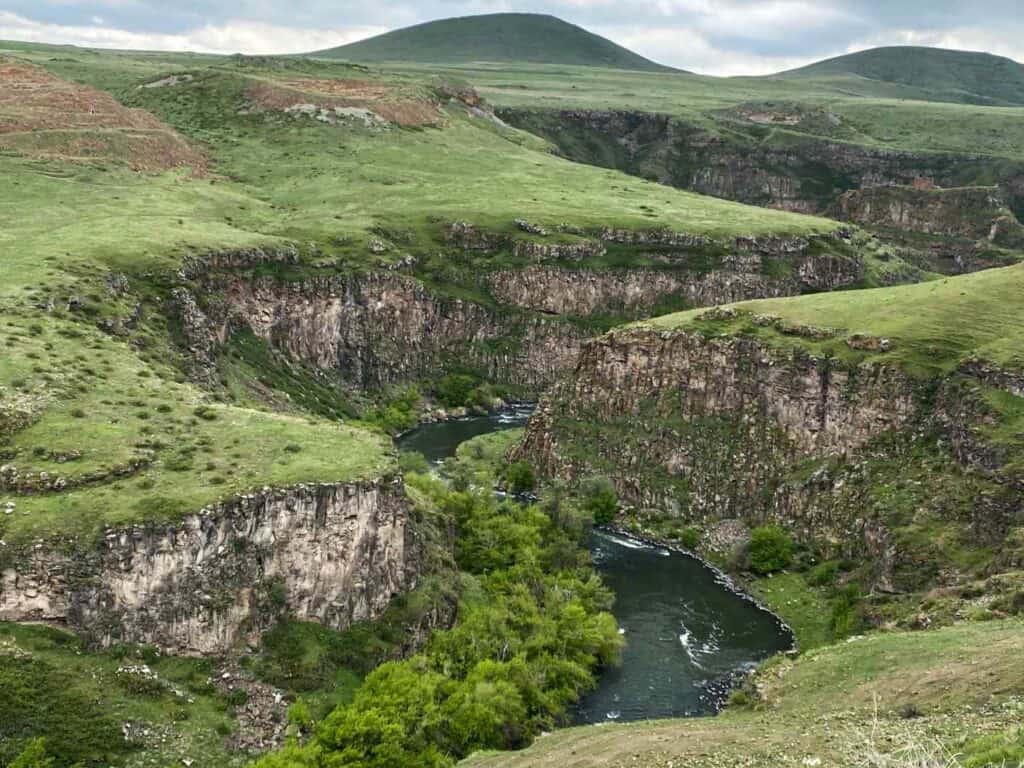
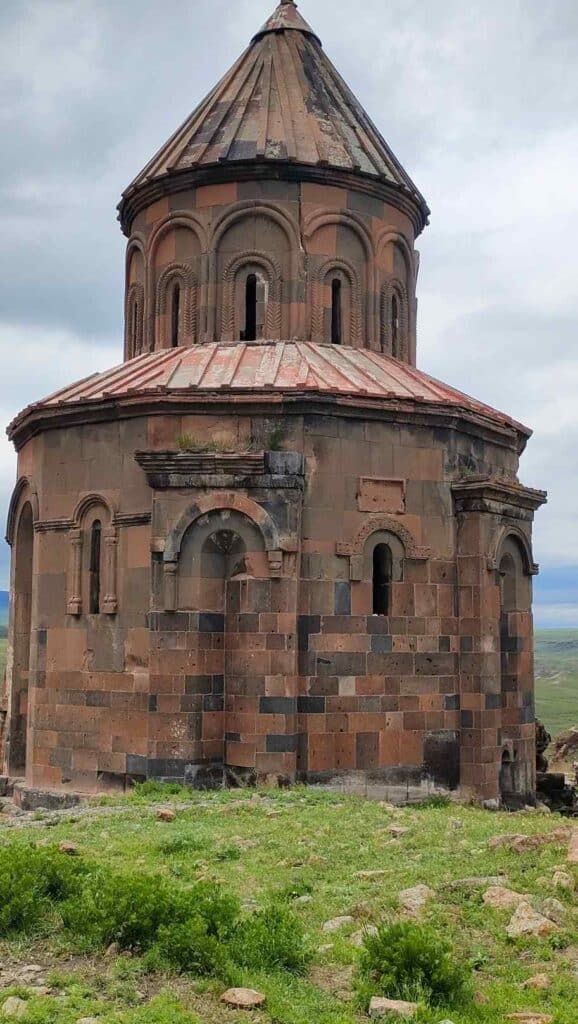
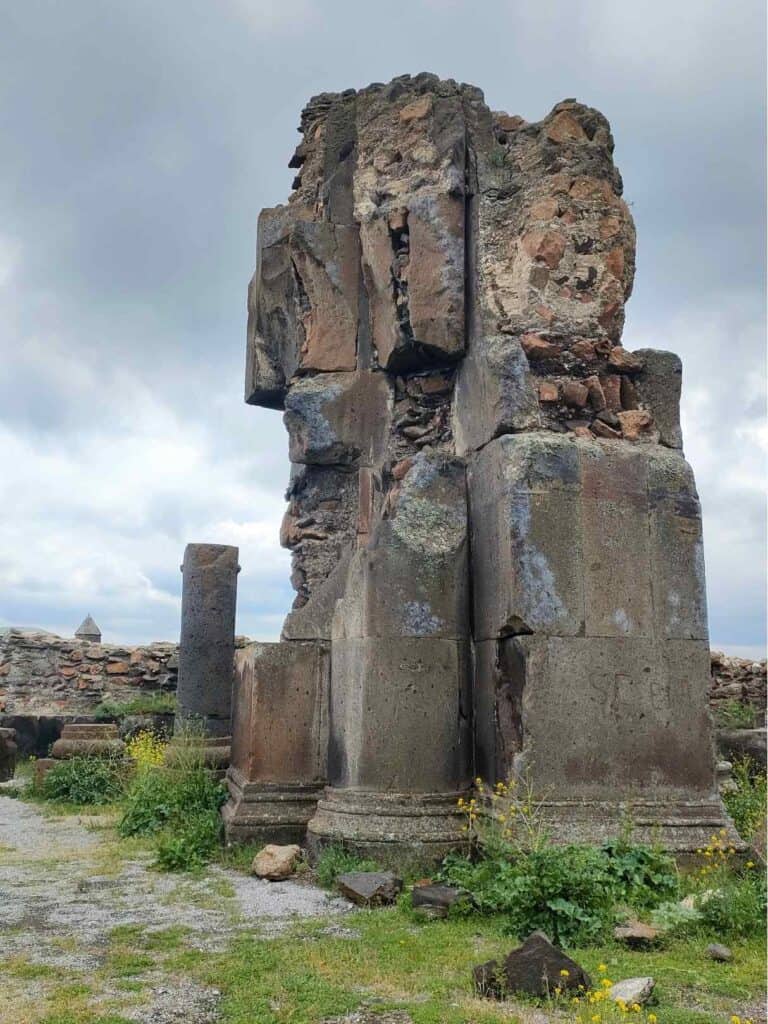
Although you can see many more beautiful Armenian churches and better-condition in Armenia, but you should visit Ani for its historical importance and the stunning surrounding green landscape interrupted by carving rivers at the bottom of deep gorges.
In the middle of the 10th century, no European settlements could compete with Ani in terms of size and splendor, and in the East it was rivaled only by Constantinople, Cairo and Baghdad. Ani thrived thanks to its strategic position between the Black Sea and the Caspian Sea.
Seljuk elements also appear in Ani’s architecture, such as the “türbe” forms, which became the standard form of mausoleums in the subsequent centuries. At that time, the Armenians were the best stone carvers in the world, and the Ani temple ruins are proof of that.
In its heyday, Ani had a population of 200,000 and was so richly endowed with sacred buildings that it came to be known as the “city of 1,001 churches.”
Finally, it was destroyed forever by Mongol invasions and a severe earthquake in 1319. Later, it was absorbed by the Ottoman Empire, and European travelers only started to visit it in the 1800s. However, its location at the sensitive border of the Ottoman, Persian, and Russian Empires remained a risky venture.
Ani is derived from Anahid, an ancient Persian goddess identified with Aphrodite. Before Saint Gregory the Illuminator, the founder of the Armenian Church, he was one of the principal deities of the Armenians. Along a tremendous east-west caravan route, the city flourished here, and the Armenian rulers later built lavish churches from the accumulated wealth. The Bagratid kings, who trace their lineage to the Israeli kings David and Solomon, placed their capital here. They were one of the leading princely families that survived after 428 when Armenia was divided between the Byzantines and the Persians. Such semi-autonomous families and their various branches served Armenia and Georgia rulers for hundreds of years.
How to visit Ani?
The temple ruins are scattered all over, and it is up to you how much you are willing to walk. If you want a good overview, you will spend around 2 hours there. Marked trails lead you along the sites till the
The highlights of Ani:
– The city walls of Ani: the massive walls that once surrounded Ani are where you enter the site
– Cathedral of Ani: It was built at the end of the 10th century and was designed by the famous Trdat, who rebuilt the Hagia Sophia dome in Constantinople after it collapsed in the 989 earthquake. It is one of the largest surviving temples in Turkey. During my visit in May 2024, it was under reconstruction, and you could not have access to the temple
– The Church of St. Gregory of the Abughamrents
– The Church of St Gregory of Tigran Honents, or Church of Saint Gregory the Illuminator, is a medieval religious structure in Ani, Turkey’s Kars province, next to the closed border with Armenia. It was built by the Armenian Tigran Honents under the Zakarids in 1215. The interior of the church is covered in frescoes, which all follow Byzantine styles
The building of the church came at a tumultuous period: in 1064, the city of Ani had been captured by the Seljuks from the Byzantines, who granted it to a Kurdish line of Muslim emirs known as the Sheddadids. Then, in 1199, the Zakarids, vassals of the Kingdom of Georgia, captured Ani with a combined Georgian and Armenian army. Their reconquest of Ani and a large part of historical Armenia greatly revived the fortunes of the region, essentially thanks to increased trade
– Ani Gagik’s church of St.Gregory
– Seljuk palace
– Menucihr Mosque
– Citadel of Ani: During my visit, the entry to the citadel was blocked by a pile of stone
– The Church of Kizkale
– The Church Of The Hripsimian Virgins
Once you reach the citadel, continue walking along the Arkurian River that separates Turkey from Amenia. This is where the most spectacular view opens up.
How to get to Ani from Kars?
There are several different information about it online. A minibus takes visitors from Kars to Ani, 40 km away. During summertime (June-July), there are probably two buses, one in the morning and one in the afternoon.
In May 2024, there was only one bus a day, at 9 am, departing from the former Antique café. It returns returns at 13:30 to Kars.
You can travel more flexibly by taxi, who will wait for you during your visit. It costs around 1200 TYR (35 EUR).
What to visit in Kars?
While you most likely arrived in Kars to visit the ruins of Ani, it is worth strolling around the city, which is famous for its handmade cheese. There are few attractions except for the Kars castle, which offers a great view of the city.
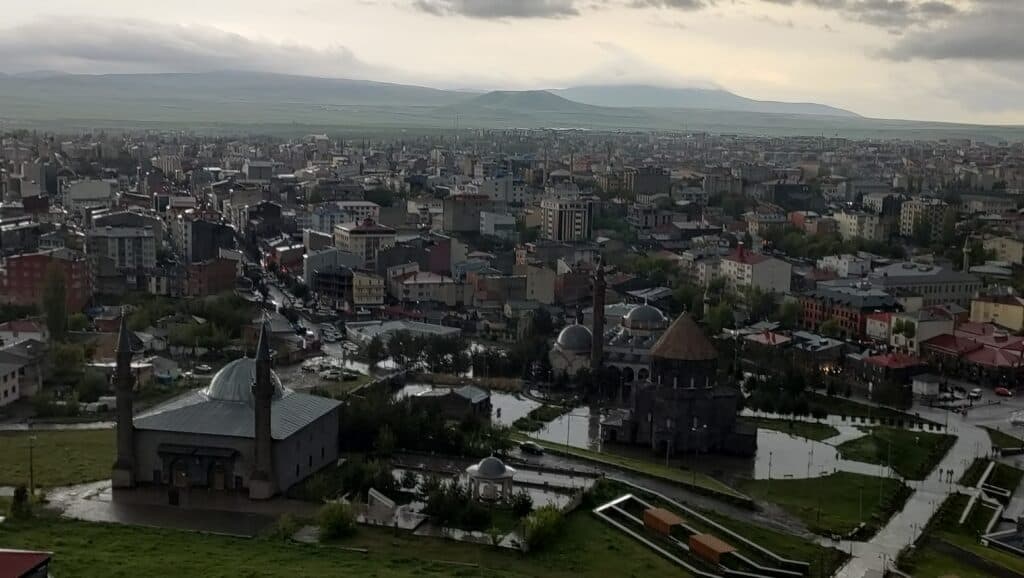
How get to Ani from Doğubayazıt?
First you must go to Igdir, where you can change to a bus further to Kars.
There are regular minibuses every hour from Doğubayazıt to Igdir starting from 7 am (one hour, 100 TYR). In Igdir, you can switch to a bus to Kars (2 hours)
Where to stay in Kars?
Low budget: Hotel Kent Ani is a nice hotel for only 20 USD. You won’t find such value for this price in more popular parts of Eastern Turkey.
Kars Konak: close to Hotel Kent Ani opposite the modern grand mosque, this hotel is another option if you are a lower budget
Mid-range: Hotel Katerina Sarayı 1877
Day 15: Erzurum
From Kars, you can take the daily train (which takes 5 hours) at 8 am to Erzurum, from where you can fly home.
Erzurum is a key city in Eastern Turkey and has the biggest university in the region. The main attraction of Erzurum is the Çifte Minareli Medresesi, the twin-minareted medrese, the largest in Anatolia. Founded in 1253 by the Seljuk sultan Alaeddin Keykubad II, grandson of the great builder of the fortress of Alanya on the Mediterranean coast, it was built in honor of his daughter, Huant Hatun, whose mausoleum is part of the medrese. Its most unique part is the 30m-high minarets, which still have a few turquoise tiles.
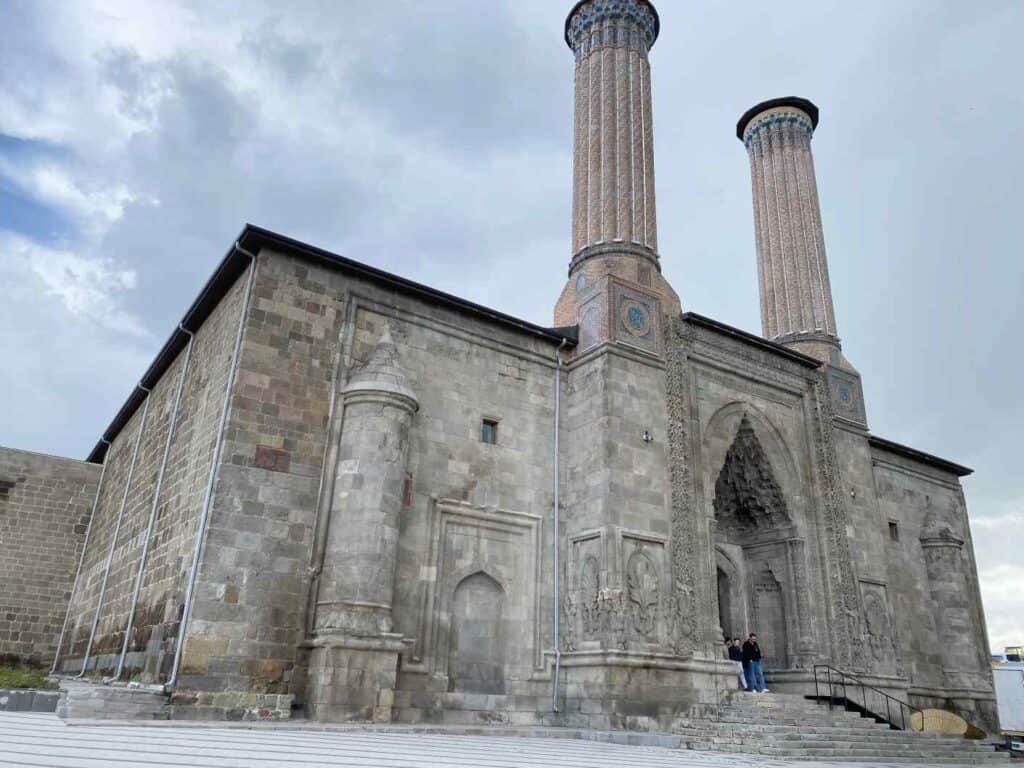
Possible Extension: Continue to the Black Sea coast: Trabzon
You can also finish your tour by including a trip to the coastal town of Trabzon. The most famous sight of Trabzon is the Hagia Sophia Cathedral, decorated with impressive colorful frescos, although its reconversion into a mosque in 2023 is highly controversial.
You can also take a short trip to Atatürk Köşkü, Atatürk’s Summer House, a few kilometers from Trabzon in the hills.
However, the main reason to include Trabzon in your itinerary is to visit the Sumela Monastery perched in the hilltop. The Greek Orthodox monastery most probably was built by Emperor Theodosius I in the 4th century.
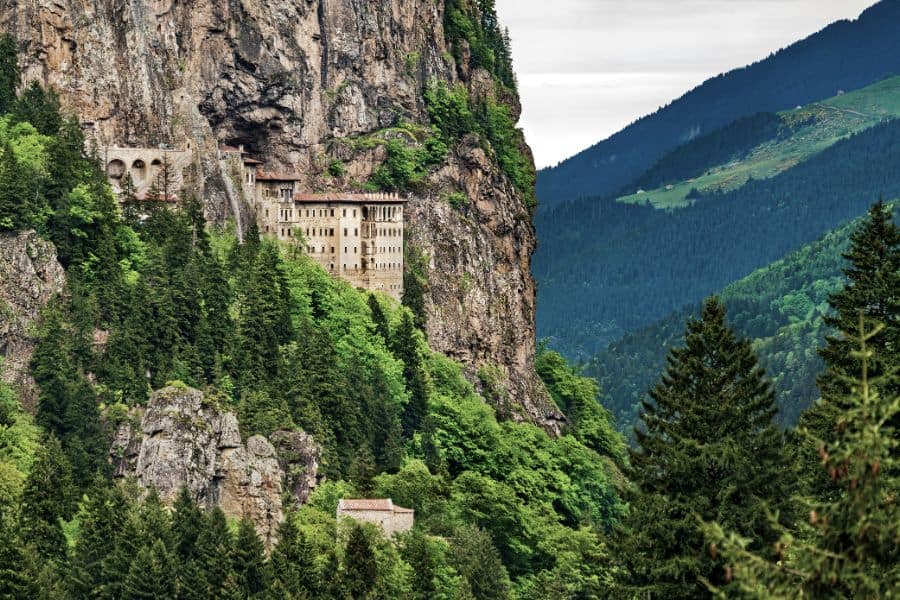
How to go to Trabzon?
You either take a bus from Erzurum to Trabzon or continue to the Black sea to Trabzon. Alternatively, you can skip Erzurum and take the scenic, less popular scenic road to Rize, the center of tea plantations and continue form there to Trabzon.
Other useful travel guides that might interest you
5-7 and 10 day travel itinerary to Jordan
The best places to visit in Lebanon in 10 days
Ultimate travel guide to Bosnia and Herzegovina
Two weeks in India including the Golden Triangle
Ladakh and Kashmir travel itinerary
These are the main highlights of Eastern Turkey; of course, there is a lot more to see. I hope that this travel guide will help you make the best plan for your trip to Eastern Turkey, an off-the-beaten-track destination that, despite the lack of information, is absolutely worth visiting.

